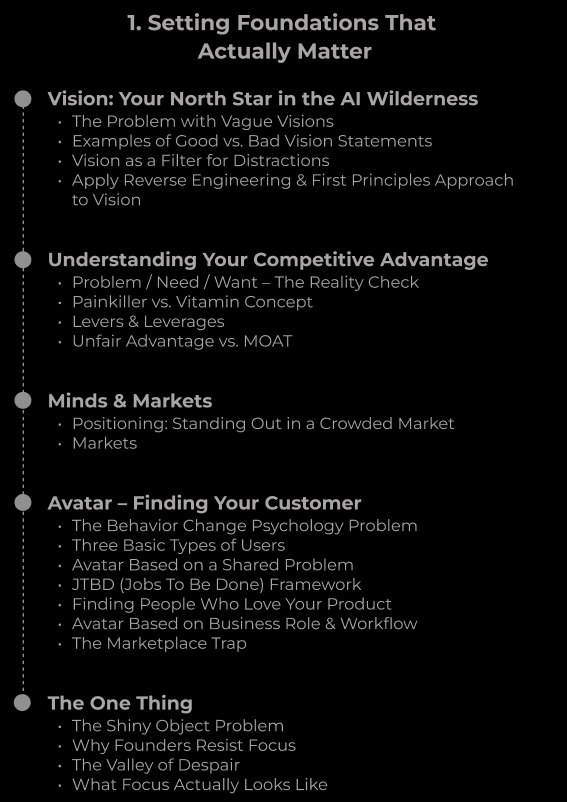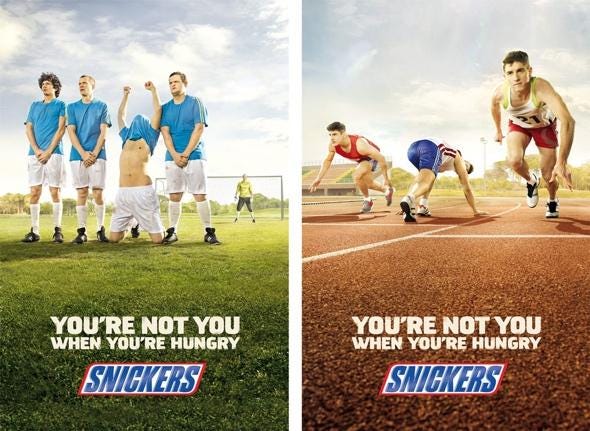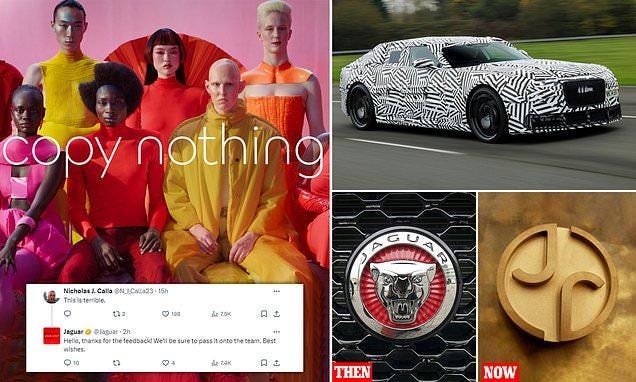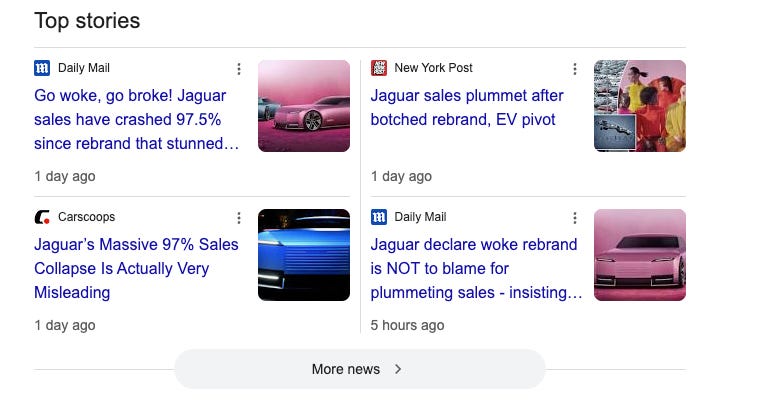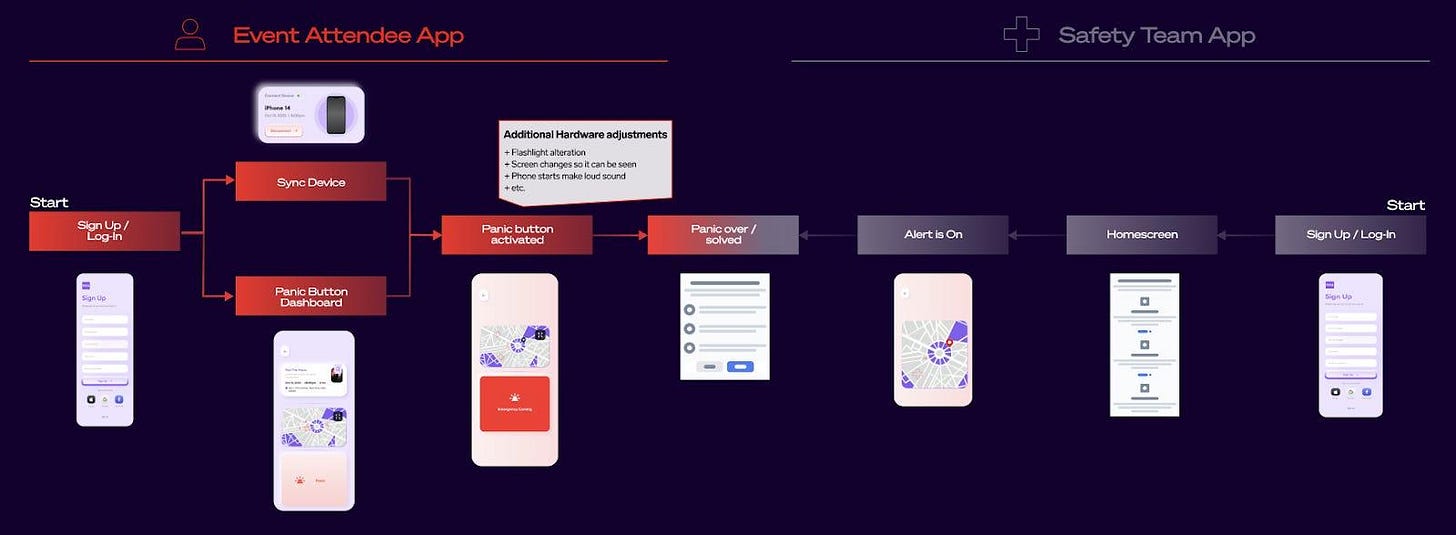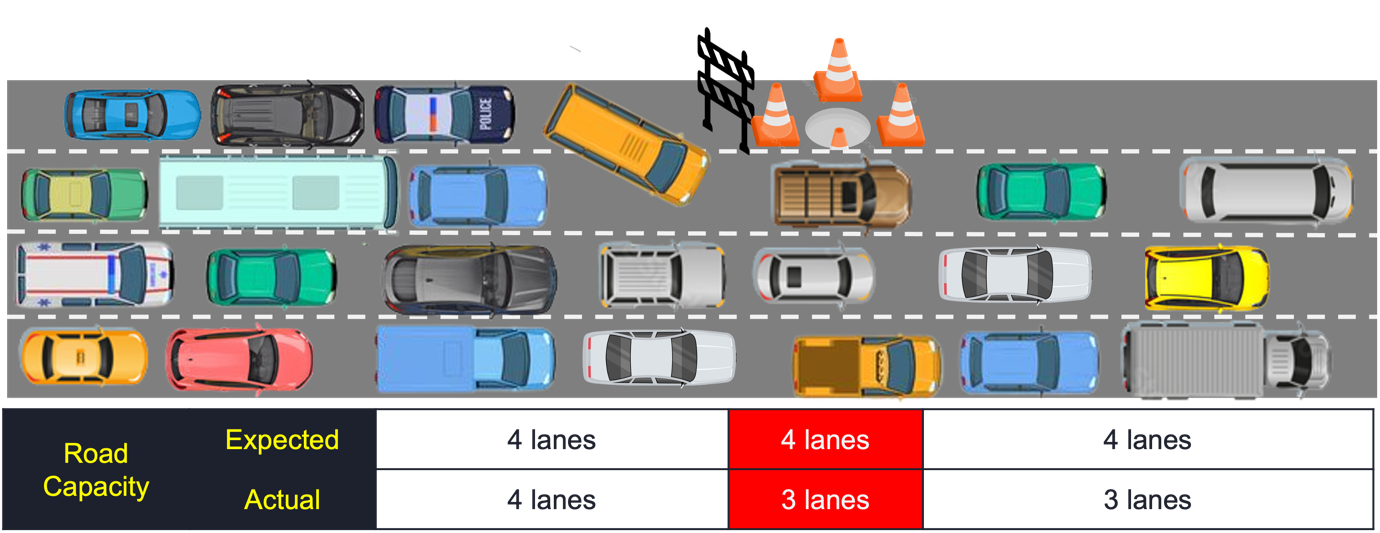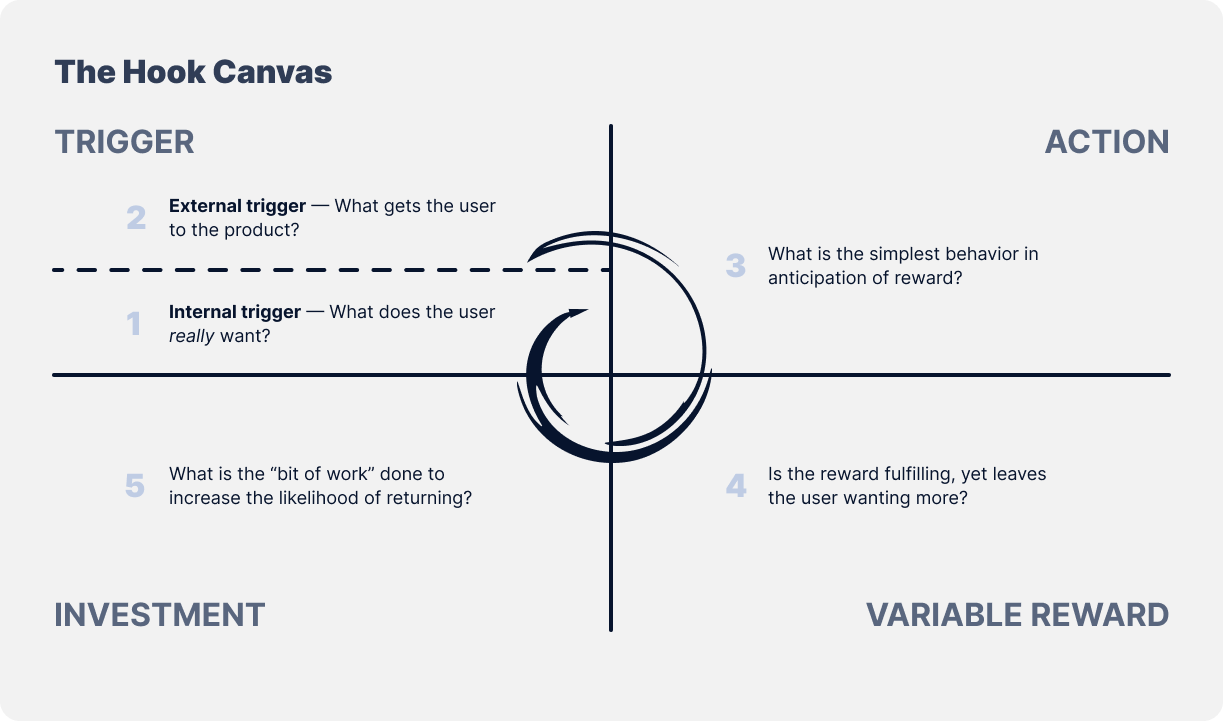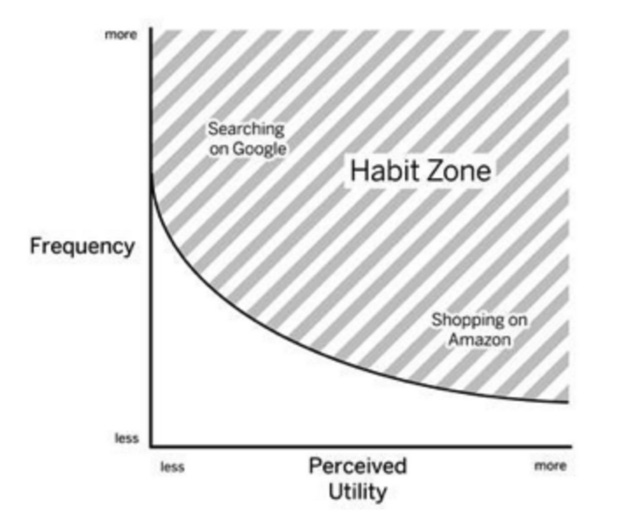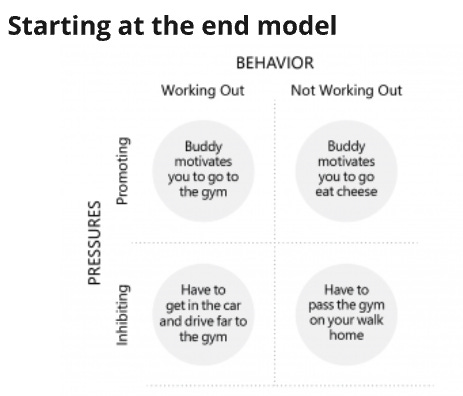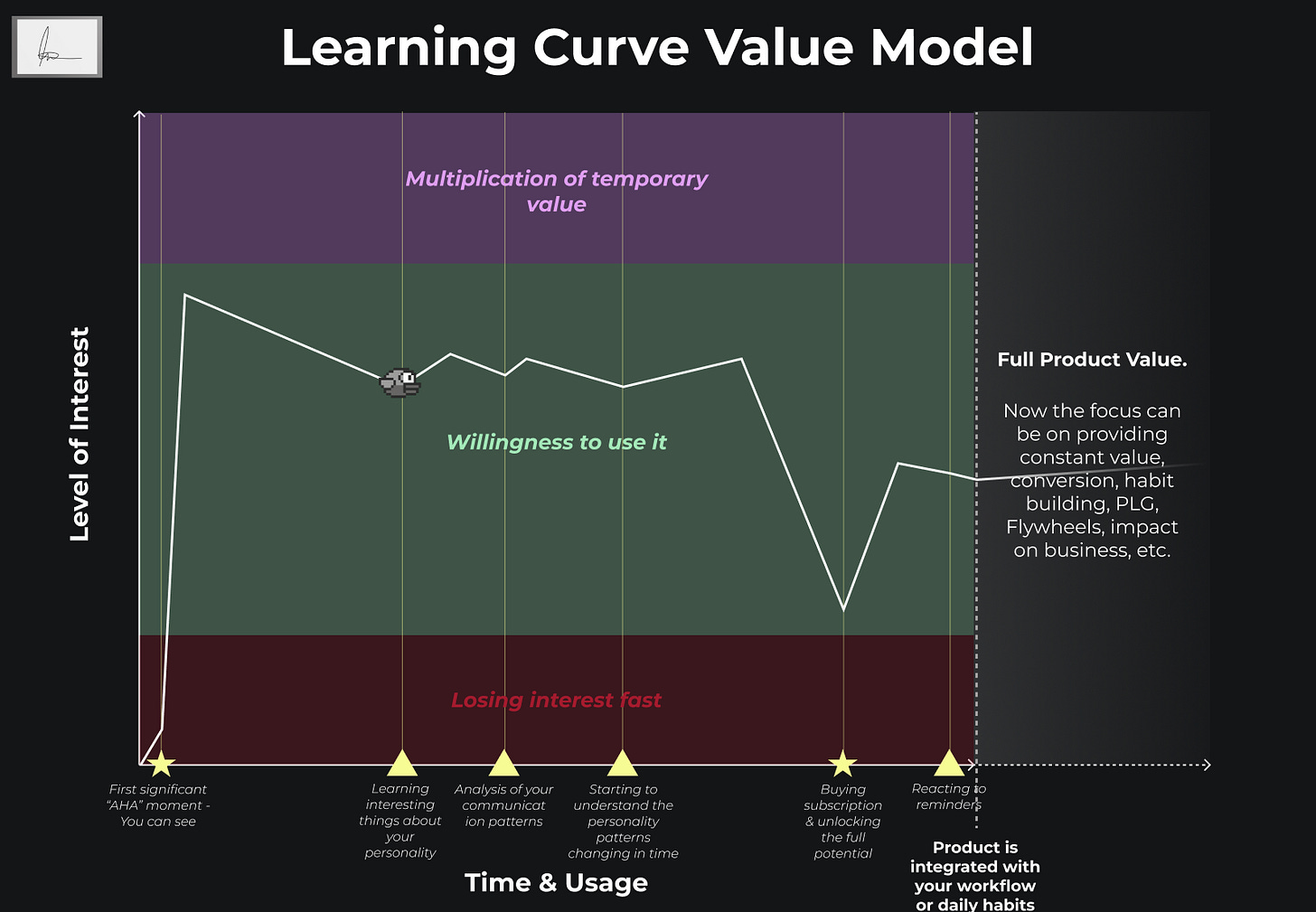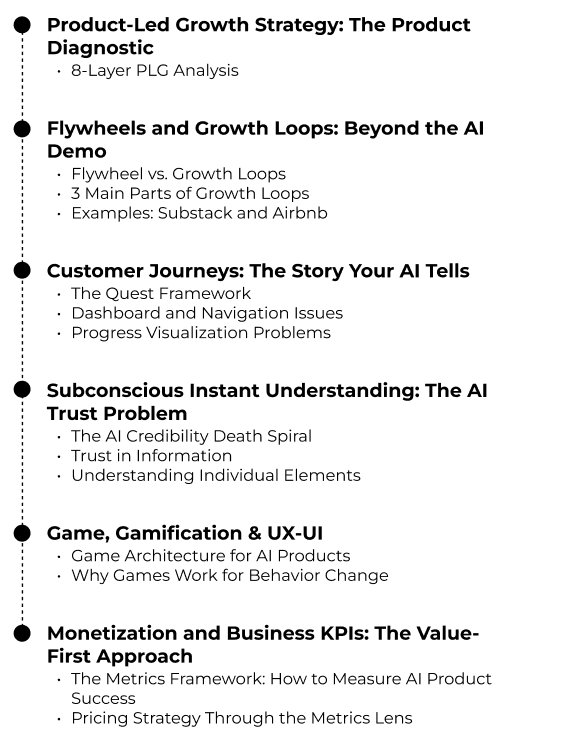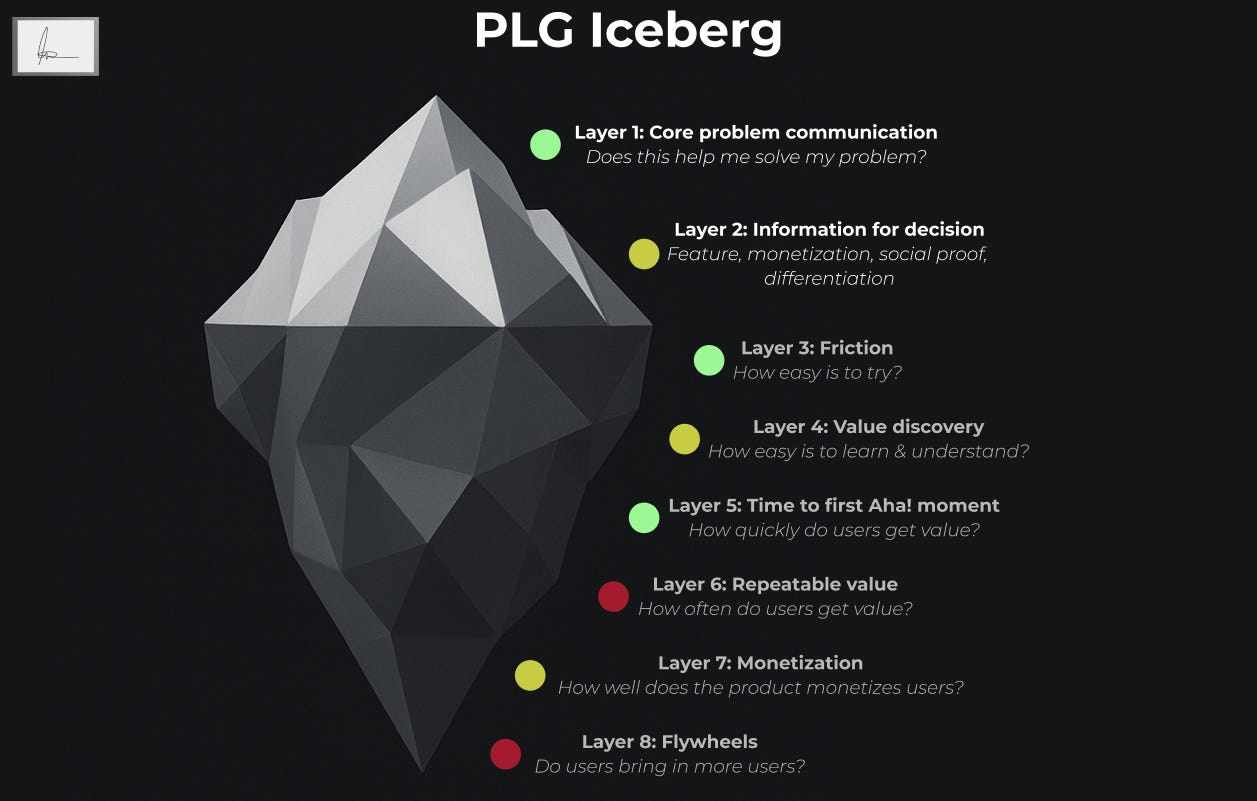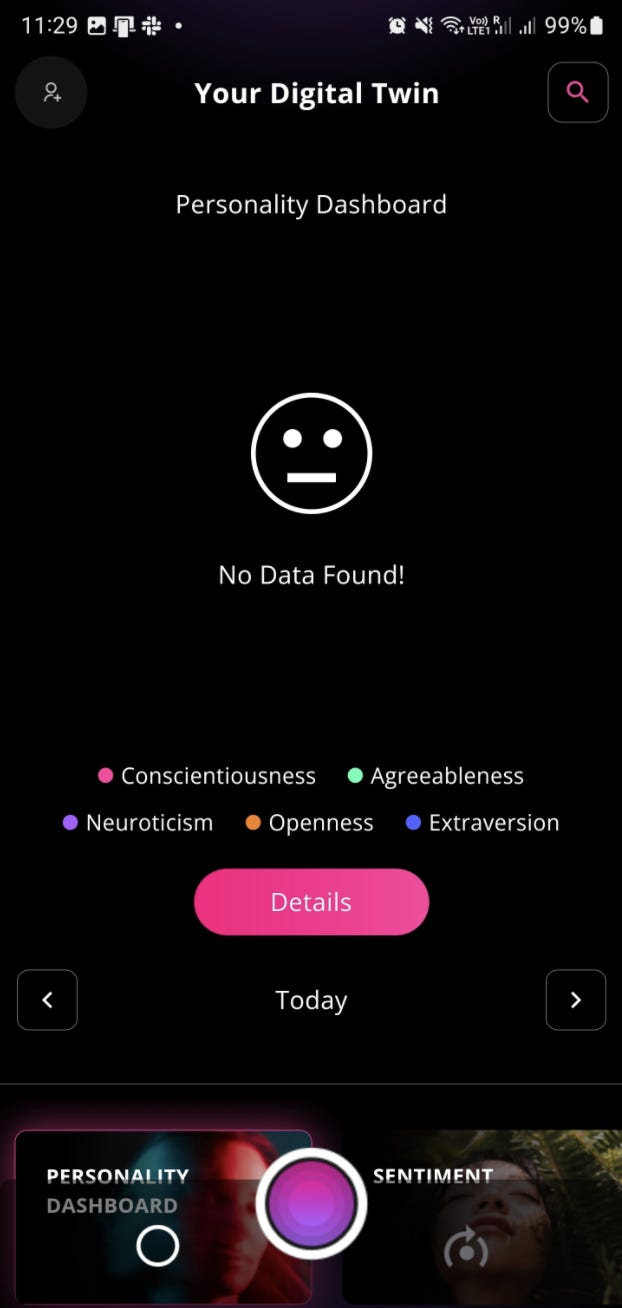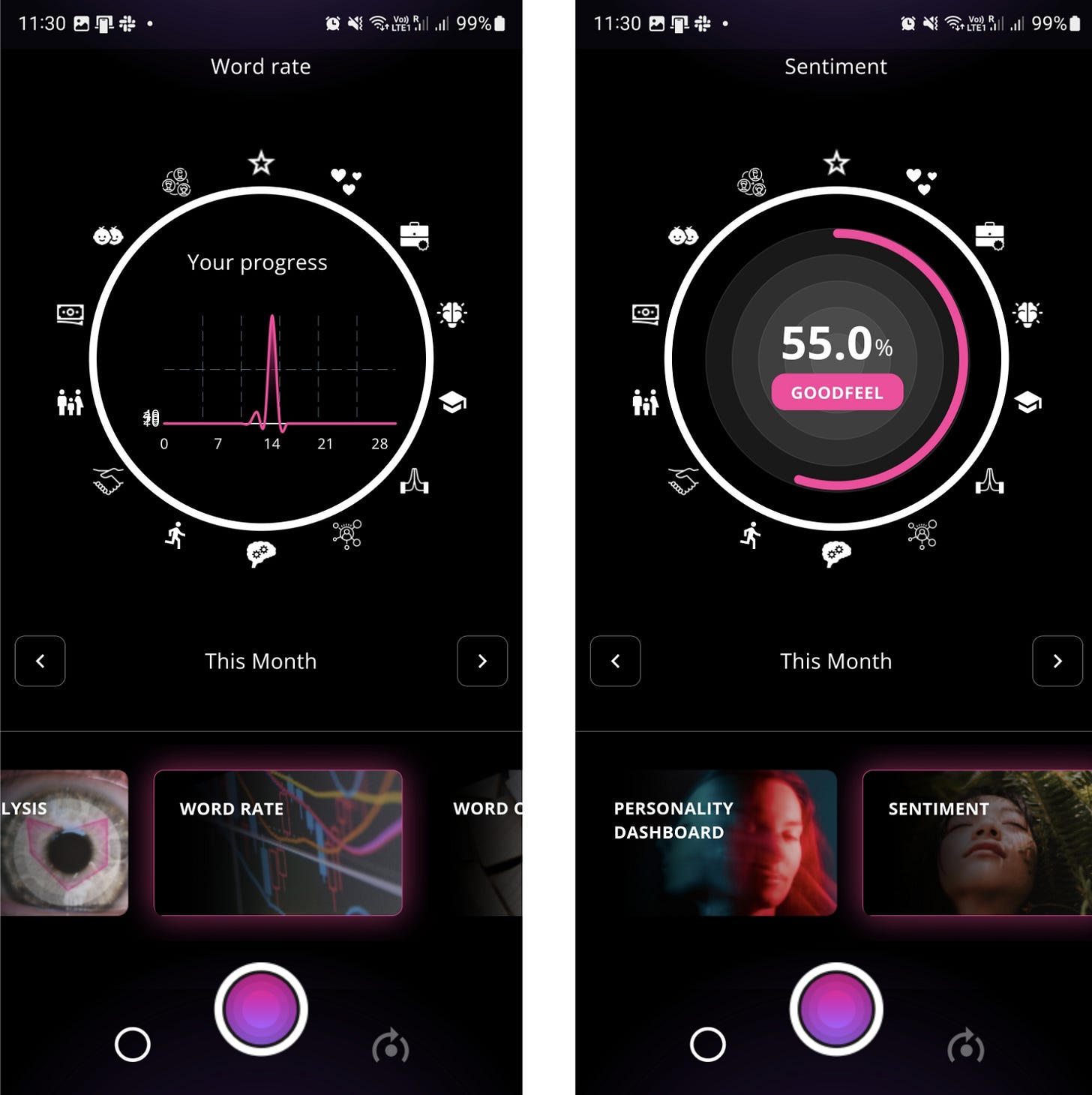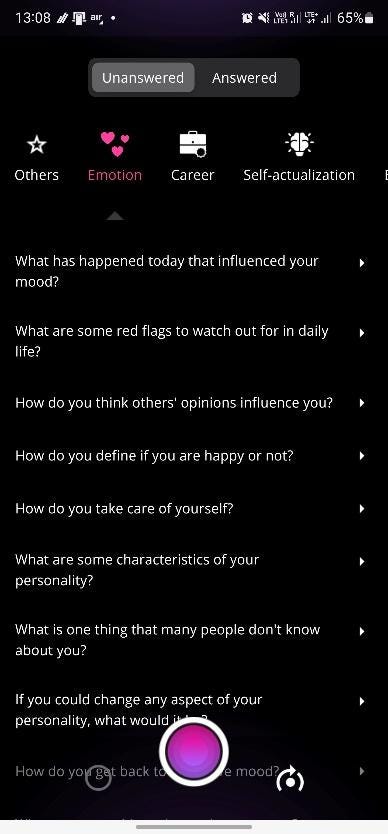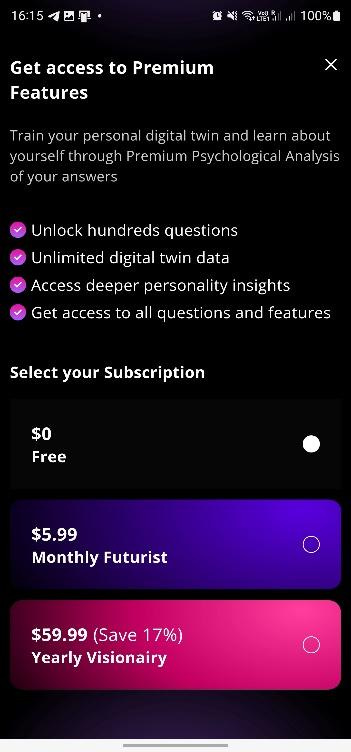Ultimate Blueprint: How to Build AI Products People Can't Live Without
The complete guide to behavioral architecture, risk management, and systematic growth for AI companies — with real case study analysis and implementation frameworks
Main disclaimer: To be transparent, some time ago I did consulting for MindBank. My main job was to figure out why people weren’t sticking with the app and to set up a product strategy. I found the answer and delivered everything, but honestly, I believe I could’ve done more if I’d approached the task systematically, considering all activities. Basically, I’m coming back to it, virtually, with the methodology and knowledge I have now.
Just so I don’t break any NDAs, and mainly out of respect for the founder, Emil, I’m only showing data and information that was publicly available on the internet. For example, the former B2C app that’s already been taken down because the startup is pivoting to B2B.
And while I’ll be talking about an AI startup, this isn’t just about AI. This should help you understand how to build a long-lasting company, grounded in solid behavioral principles.
Table of Contents A.k.a. Framework Used
I usually use 3 main frameworks: the vision to button approach, visible vs. invisible behavior analysis, and the expectation to current behavior gap.
These are the ways I systematically apply behavioral insights to startups, products, and innovations. In this article, we'll focus mostly on the vision-to-button approach, meaning we start at the very top and analyze everything from the startup's vision down to individual buttons.
Here's how this approach looks, which also serves as our table of contents:
The Story: My Favorite AI Startup That Pivoted Too Soon {#the-story}
An AI startup called MindBank, was trying to create your digital self, something like Jarvis from Iron Man.
I still consider it one of my favorite startups out there, so I hope Emil pulls it off.
Here’s what the promo video for the app looked like:
After I downloaded the app, I immediately saw some basic logical flaws across different customer journeys, but I knew that the foundation, the idea, and the vision were solid.
So I went to check out what people were saying in the comments because your idea is only as good as how well it's accepted in the market.
The app didn't have great reviews, but after digging deeper, I identified that I had stumbled onto an idea with massive potential.
You have to keep in mind that this was still in the early days of AI agents and nobody was talking about them yet. Now they're everywhere, but this kind of execution is still one of my favorites.
Most comments were along these lines: people praised the idea, they really wanted to try it out, but they had issues with the technical implementation, the AI didn't process data well, and the overall UX/UI was pretty confusing.
Here's what gave me conviction about the quality of this idea: There's nothing better than when people are rooting for you to succeed despite the large number of flaws your project has. Because at the end of the day, everything like that can be fixed fast.
These were my assumptions:
Technical problems = we'll solve them by addressing or reducing the scope, meaning we'll cut out some unnecessary features to ease the development load
AI shortcomings = with progress this fast, it's just a (short) matter of time, until a new update solves it
UI improvements = this is fully in my hands, so I'm confident I can sketch it better
So in this case, I trusted that the product had found its initial PMF (Product-Market Fit). Probably the most important initial thing to find when building AI startups, or any kind of startup.
Since I saw the potential in this product, and at the very least knew I'd enjoy working on this startup, I reached out to Emil to say I could help take the app to the next level.
Even though I believe my contribution was solid, it was clear how much work lay ahead. With limited funds, the project decided to pivot into B2B. Looking back, I realize I should have stepped back and challenged the overall strategy, not just focused on individual product areas. That wasn't entirely in my scope at the time, but I should have pushed for it anyway.
I wasn't addressing the root causes; I was treating the symptoms.
But I guess, without that, my pursuit to understand all the connections, as well as this article, would never have happened.
But let’s start from the beginning…
Why Most AI Startups Are Built on Sand {#why-most-fail}
My goal is to show you how to build a company that lasts, not one built on trends or "castles made of sand."
If you're just looking to cash in on whatever's hot right now, this probably isn't for you. But if you want to build something big with solid foundations, something you'll love that creates real value for customers and founders, keep reading.
Here's the brutal truth: Most startups today are just wrapping existing solutions with a nice UI and calling it innovation. They're playing the features game when they should be playing the systems game.
We'll start from the top — vision and strategy — then work our way down to individual product decisions. Think of it as going from 10,000 meters all the way down to the details that matter.
The AI Startup Trap
Here's what I see happening everywhere:
Feature Obsession: "We're building ChatGPT for lawyers," or "We're building Midjourney for real estate."
Model Dependency: Building entire companies on top of someone else's model without any defensibility
Solution Looking for a Problem: Having amazing AI capabilities but no clear customer pain point
Ignoring Human Psychology: Assuming people will change their behavior just because the AI is "better"
This is exactly what happened with MindBank. It had incredible vision and solid setup, but we didn't nail the fundamentals that make AI companies actually succeed long-term. Or even make people stay around.
Where do we start? With something I call...
1. Setting Foundations That Actually Matter {#foundations}
First, I want to address a key point about methods and frameworks in the AI space.
Every time people set out to build an AI company, they grab the most well-known approach, usually "find a use case for GPT", and cling to it like it was handed down from Silicon Valley heaven.
All these frameworks are just proven aids, tools you apply to your specific problem or company. They are not mandatory steps to follow at all costs. They're TOOLS, not the FOUNDATIONS.
I'm pointing this out because even when working with so-called "innovative" agencies focusing on building AI, I've hit resistance if I didn't stick to the established frameworks, despite clear inefficiencies and negative impact on the client.
Vision: Your North Star in the AI Wilderness
In all my work with startups, vision is more about explaining what these things are actually good for, because everywhere else you'll just read about how important vision is, how to approach it, and how to come up with it.
But no one really asks at a fundamental, deep level: why do we even need it specifically? And where do people go wrong with vision constantly?
Here's the problem: Most people show me their vision — whether it's "democratizing access to information" or "making everyone more productive" — and these sound impressive, but they're completely useless for making actual decisions.
These visions are so vague that they could apply to thousands of different companies. They don't define any specific behavior change you're trying to create. They don't tell you what success looks like day-to-day.
When I ask founders with these grand visions to show me their current activities, all I see is complete chaos. A common phrase is "that's where we're headed" — and I just say: "You do know that once you clarify your vision, every single thing you do should either be part of the puzzle or a step that moves you closer to that goal."
The difference between vague and specific vision:
Vague vision: "We want to make communication better." Specific vision: "We want to eliminate email for team communication by making real-time messaging feel as natural as talking in person."
Vague vision: "We want to democratize finance."
Specific vision: "We want to make it possible for anyone to invest in the stock market with just $1 and no fees."
Vague vision: "We want to improve healthcare." Specific vision: "We want to make it possible for people to get diagnosed for common conditions without ever leaving their home."
Examples of good, specific visions from real companies:
Tesla: "To accelerate the world's transition to sustainable energy"
Specific outcome: transition to sustainable energy
Specific role: accelerate that transition
Clear behavioral change: people switch from gas cars to electric
Airbnb: "To create a world where anyone can belong anywhere"
Specific outcome: feeling of belonging anywhere
Specific behavioral change: people stay in strangers' homes instead of hotels
Clear measure: expansion of where people feel comfortable staying
SpaceX: "To make life multiplanetary"
Specific outcome: humans living on multiple planets
Specific behavioral change: space travel becomes routine
Clear measure: sustainable human presence beyond Earth
Netflix (original vision): "To become the best global entertainment distribution service"
Specific outcome: global entertainment distribution
Specific behavioral change: people stream content instead of renting DVDs
Clear measure: global reach and convenience
Notice how each of these visions immediately tells you:
What specific change they're trying to create in the world
What behavior they want people to adopt
How you'd measure if it's working
Bad visions that tell you nothing:
"Empowering people through technology"
"Making the world more connected"
"Democratizing access to information"
"Creating a better future"
These could describe any company. They give you zero guidance on what to build, whom to serve, or how to measure success.
Vision isn't just about where to go — it's mainly about where not to go and what not to do, because those things won't get you to your breakthrough 10x faster.
You get these extremes where someone says they want to be a disruptor, and then I see them copying and slightly improving what their competitors do, because hey, they're learning and making things better.
But I say: true disruptors listen only to their customers, look at the biggest problems, learn from failures and pivots, and keep competitors somewhere in the back of their mind at best.
A good vision should be so specific that when someone suggests a new feature or partnership, you can immediately ask: "Does this move us closer to our vision or not?" If the answer isn't clear, your vision isn't specific enough.
Vision isn't just about where to go — it's also about where not to go and what not to do. And that’s the key distinction. Because sometimes saying no to opportunities and focusing gets you to your breakthrough 10x faster.
You get these extremes where someone says they want to be a disruptor in AI, and then I see them copying and slightly improving what OpenAI or Anthropic do, because you know, they're learning and making things better.
But I say: true AI disruptors listen only to their customers, look at the biggest problems, learn from failures and pivots, and keep competitors somewhere in the back of their mind at best.
„The North Star“
If you have your vision and you know the steps toward it, then if you want to achieve it, every activity, every second at work, should be moving you closer to that goal.
Way too many founders waste time on complete nonsense that either isn’t important at the moment or could easily be outsourced.
When I started my first company, I already had branded pens, notebooks, and an office, but no clients yet. I was doing online analyses, but everyone kept telling me I needed to look presentable.
A friend of mine bought a van at the start of his business instead of renting one, even though he didn’t have a stable client base yet.
I see this kind of thing non-stop.
Countless startups burn through investor money on the most expensive gear because “it’s needed for work.” Tons of articles have been written on this.
Alex Hormozi regularly talks about how he was making hundreds of thousands but still lived in the same apartment or drove a beat-up car.
Elon Musk and his brother coded in one room on a single computer they took turns on, and when they started making money, the first cash didn’t go on cars or fancy offices.
Vision should serve three main things:
A filter for all distractions
A tool for making key decisions about direction
Keeping activity consistent so you can achieve compound results
Basically, it helps you keep your eyes on the prize.
MindBank vision?
MindBank had a very strong vision — to create your own digital self. To be a source for artificial consciousness and create a platform that preserves thoughts so people can live on through their data.
A powerful vision. Maybe too powerful for very limited funds and lack of a world-class team. But of course, that’s debatable.
But in my view, at the start, we didn't properly reverse-engineer all the steps or clarify the direction, because we kept pivoting too often. We went wherever the money was and pivoted before we really found out whether the idea worked.
Pivoting is important, but only once you've exhausted the activities. A lot of founders pivot too soon, especially when they hit those boring, really hard phases of building actual user habits.
As we saw, MindBank had interest from people, so the pivot here was a textbook case of that graph above, which usually happens because of a lack of resources or because founders get scared when they see what bigger players have just released.
The most important thing is to break your vision down to the very first steps, because that's where every company either fails or becomes something that matters.
Quick Action Items:
Write your vision in one sentence that a 12-year-old could understand
List the 3 biggest assumptions your vision relies on
Identify which of these assumptions you can test this week
Apply Reverse Engineering & First Principles Approach to Vision
If you have a vision that’s bold but achievable, you should reverse-engineer your way back and outline every single step that needs to happen to get closer to it.
Then you should validate each step of that vision, ideally using first principles thinking, which is crucial because most "best practices" in any new space are actually just borrowed from other industries.
First principles thinking means you don't reason by analogy (what others do), but you break the problem down to its basic facts, the first principles, and build your solution from there.
Instead of asking "How do others do it?", you ask:
👉 "What is this actually made of?"
👉 "Why does it even work this way?"
👉 "What do I know is really true about human behavior — and what's just an assumption?"
That's what the best companies do. They don't just build "X for Y" — they ask why Y exists in the first place and whether their technology can fundamentally change that equation.
That’s what Elon Musk did when he figured out that rockets don’t have to cost hundreds of millions, because by breaking it down to raw materials and manufacturing, the price came out way lower.
In practice, this is harder to do, but it’s extremely powerful because it lets you see new solutions where others are just copying.
Elon Musk is probably the best example of someone who thinks like this in everything he does, and it’s brought him more than unusual results.
I tried to very briefly illustrate this in the case of his companies:
Tesla:
SpaceX:
Understanding Your Competitive Advantage
Here's where building any startup gets interesting, and where most people mess it up.
Pressing Problem / Need / Want – The Reality Check
On the internet, all you ever hear about is the need to solve the user's problem, ideally, a problem nobody's tackled yet, or finding a more efficient solution to an existing problem.
This mainly comes from the startup world, where the goal is to change the world or hit a billion-dollar valuation. And from there it trickles down to the public.
Many times, some, I would not say founder, but also entrepreneurs, get confused by that.
But in reality, there are tons of successful companies that, at their core, don't really solve any urgent problem at all.
What problem does Snickers solve? Does a Rolex really tell time better than any other watch? What problem does TikTok solve? Is Spotify truly essential when radio exists? Does that meditation app really solve a problem, or is it just nice to have?
I'd rather place solutions like the need or want sub-category.
Sure, before these solutions existed, you could argue they filled a problem gap, but later they shifted into other categories.
I don't have a blood sugar issue, I'm just used to sweet stuff, so I feel the need for a Snickers.
I don't need to know the time, I have it on my phone, but I want the status, so I buy an expensive watch.
I don't need another way to consume content, but I want the entertainment, so I scroll TikTok.
If we understand where on this spectrum our product lands in people's minds, we can adjust the marketing, the service design, the behavior, and the overall approach accordingly.
Here's what changes behaviorally for both the entrepreneur and the user:
When you solve a pressing PROBLEM:
Entrepreneur mindset: Focus on immediate pain relief, faster sales cycles, higher urgency
User behavior: They actively seek you out, are willing to pay more, and prefer faster decision-making
When you fulfill a NEED:
Entrepreneur mindset: Build habits and routines, focus on retention over acquisition
User behavior: They integrate you into existing patterns, moderate loyalty, and price-sensitive
When you satisfy a WANT:
Entrepreneur mindset: Heavy marketing investment, focus on desire creation, brand building
User behavior: Impulse-driven, easily distracted by alternatives, needs constant engagement
I don't think that a digital self solves some massive problem I have. Sure, remembering stuff and having info about yourself is great — but it's more of a want than a must-have problem that's screaming for a solution.
This is basically the same principle as the vitamin vs. painkiller concept Mark Andreessen popularized:
Painkiller → A product that solves an acute problem. Something that actually hurts the customer, and they want it solved right now. Example: migraine medication, software that automates annoying tasks, accounting tools at tax time.
Vitamin → A product that's nice to have, but the world won't fall apart without it. It improves quality of life, but there's no urgency. Example: meditation app, eco-friendly water bottle, designer notebook.
Painkillers sell because customers have a problem and are looking for a solution. Vitamins need marketing so the customer even understands why they want them.
Here is an ultra-short but quite good blog on this whole topic.
MindBank? It was more of a vitamin — maybe with a bit of pain relief sprinkled in.
At the same time, it was something people wanted, and my goal was to turn it into a need so that eventually we'd uncover the deeper, real problems this service could address.
Understanding these "small" differences has a huge impact on everything else you do. If you know where your product fits, the next step is to identify your levers.
Levers & Leverages
"Give me a lever long enough and a fulcrum on which to place it, and I shall move the world." – Archimedes
Successful entrepreneurs are always looking for levers, unfair advantages they have. There isn't a day that I don't see how I underestimated the power of leverage.
Here are the relevant leverages you should have in mind:
Network Effects
Your product gets more valuable as more people use it — not just better for you, but actually better for each user.
Example: The more people use your communication platform, the more valuable it becomes to each individual user.
Data Compound Effects
Unlike traditional advantages, some products get better as more people use them. Your system learns from user interactions, becomes more accurate, more personalized.
Example: The more people use your recommendation engine, the better it gets at understanding preferences in your specific niche.
Workflow Lock-in
Once users develop habits around how they work with your product, switching becomes painful, not because of data, but because of learned behavior.
Example: Figma works exactly how designers already think — switching means relearning how to think about the problem.
Proprietary Access
You have access to something that others don't — data, distribution, partnerships, or insights that give you a continuous advantage.
Example: Having partnerships that give you unique access to customers, or generating insights that competitors can't replicate.
Or you can use the framework key leverages from 7 Powers: The Foundations of Business Strategy:
MindBank? At that point, it had potential for switching costs through data accumulation. The more information users loaded into the app, the better their responses would get, and the harder it would be to leave and start over with a competitor. Also, the personality of their digital twin would be much more precise.
Something I always kept in mind when working on partnerships and building products, and what a lot of people ignore, was the need for unfair advantages and, over time, the potential to build an unfair advantage and essentially a MOAT.
Unfair Advantage
This is something you have, and others don't. And ideally, it's something that isn't easy to copy.
It's your "unfair advantage" — what gives you a head start even if you're smaller or new on the scene.
It could be:
Know-how from a unique experience
A strong network others don't have
Community effect
Speed in decision-making
Access to certain people, distribution, or resources
Example: If you have long-term relationships with a community of influencers — maybe they're your friends — and they can help promote your stuff for free and super fast, that's an unfair advantage.
Everyone else will wait six weeks and pay thousands. That's a real-life example.
I had a conversation with a friend who used to be a YouTuber and now runs a travel agency for young people. He said he didn't know much about business, but still managed to get it off the ground. I told him he didn't realize the unfair advantage he had, most of the well-known influencers in Slovakia went on his trips, and his personal brand had always been about fun and experiences. No wonder he grew even during COVID.
What people don't realize, especially at the start, is that unfair advantages aren't just business-related; they can be personal.
A basketball player who's 6'3" has a huge built-in advantage from day one.
For me, for example, it took seven years to realize I understood business and product architecture and the connections between things better after two months in a role than some colleagues who'd been at it for eight years.
So, write down what you think your unfair advantages are.
MOAT
A term coined by Warren Buffett — the defensive moat around your business that protects you from competitors.
The deeper and wider your moat, the harder it is for someone to catch up or overtake you, even if they have access to the same basic tools you do.
There's a brutal scene in the TV show Billions where Bobby Axelrod explains to his wife why investors rejected her business. He breaks it down cold:
"What is it that you do that you're the best in the world at? You offer a service you didn't invent. A formula you didn't invent. A delivery method you didn't invent. Nothing about what you do is patentable or a unique user experience. You haven't identified an isolated market segment. Haven't truly branded your concept... So why would an investment bank put serious money into it?"
That's the MOAT raw questions in their rawest form. If anyone can copy everything you do tomorrow, you don't have a business, you have a temporary advantage at best.
Different types of moats include:
Examples:
Midjourney — taste + community + behavioral moats
Notion — integration + behavioral moats
Figma — workflow + network moats
In simple terms:
Unfair Advantage gives you an edge now (offense)
MOAT protects you long-term (defense)
You want both. You need at least one.
The problem was, I couldn't really find MindBank's unfair advantage, except for data later, but that is for everyone. That's why I tried to dig through the entire customer journey and focused on gamification.
But looking back, we should have been building data moats through user interactions rather than trying to gamify engagement.
Minds & Markets
Minds - Positioning: Standing Out in a Crowded Market
There's a line I love from Nipsey Hussle:
"But she could be whatever she wants, except average."
This is how I want to go above life in everything I do.
Honestly, positioning could be an entire article in itself; there are books written on this topic. But I want to focus on why it's absolutely critical from a behavioral perspective, because most people think positioning is just marketing fluff.
It's not. It's psychology.
Positioning is a clear answer to the question: "Who are you for?" and "Why are you the best choice for them?"
It's the mental space your brand or product occupies in the customer's mind, compared to everyone else.
In short:
It's not about what you're selling, it's about how your target customer perceives it
Good positioning makes decisions easy for your customer, because they know who you're for and who you're not for
Why Positioning is Behavioral, Not Just Marketing
Here's what most people miss: your brain is constantly trying to categorize everything to make decisions faster.
When someone encounters your product, their brain immediately asks: "What category does this fit into?" and "Do I need something from this category right now?"
If you don't give them a clear category, their brain gets frustrated and moves on. It's not a conscious decision; it's automatic cognitive behavior.
Example:
Volvo? → Safety
Red Bull? → Energy
Uber? → Convenient transportation
Your brain instantly knows what job each brand does and when you might need them.
The Hidden Cost of Bad Positioning
Bad positioning doesn't just confuse customers — it creates invisible misalignments throughout your entire company.
Here's what happens behaviorally:
For customers:
Decision paralysis (they can't figure out if they need you)
Expectation mismatches (they think you do X, but you actually do Y)
No word-of-mouth (they can't explain to others what you do)
For your team:
Feature creep (everyone has different ideas about what you should build)
Marketing inconsistencies (different people emphasize different benefits)
Sales confusion (reps don't know which pain points to focus on)
I see this all the time. A company will have amazing technology, but their team is pulling in five different directions because they have never clearly defined what job they do for which type of person.
The Colgate Food Disaster: When Positioning Goes Wrong
Let me show you a perfect example of positioning gone wrong.
Most people immediately see Colgate and think: oral hygiene, clean teeth, fresh breath.
That's decades of consistent positioning.
So why not ruin it?
In the 1980s, Colgate decided to launch a line of frozen meals. Yes, frozen dinners. With the Colgate brand name.
The result? Immediate consumer disgust. People couldn't separate "toothpaste taste" from "food taste" in their minds. The product failed spectacularly.
This wasn't because the food was bad — it was because Colgate had trained people's brains for 50+ years to associate their brand with one very specific job (clean teeth), and suddenly asking them to associate it with a completely different job (feed hunger) created cognitive dissonance.
Your brain literally couldn't handle it.
Jaguar, for example, absolutely butchered their positioning with their new rebranding.
It’s not just that it was “woke” or whatever. The point is: I used to see Jaguar as an elegant, luxurious, fierce car with a timeless vibe.
And they are now paying the price:
What can I say.
The Behavioral Mechanics of Good Positioning
When you nail positioning, you're essentially programming a shortcut in your customer's brain.
Good positioning creates:
Recognition shortcuts: Customer immediately knows what you do
Need triggers: When they have the problem, they think of you first
Trust signals: Clear positioning feels more competent and reliable
Decision confidence: No second-guessing, no comparison shopping
Bad positioning creates:
Cognitive load: Customer has to work to understand what you do
Category confusion: They can't figure out when they'd need you
Trust erosion: Unclear positioning feels amateur or deceptive
Analysis paralysis: Too many options, so they choose none
How Positioning Affects Every Business Decision
Once you have clear positioning, it acts as a filter for every decision:
Product decisions: "Does this feature align with how we want to be positioned?"
Marketing decisions: "Does this message reinforce our positioning?"
Partnership decisions: "Does this partnership strengthen our position in this category?"
Hiring decisions: "Does this person understand our positioning and can they execute it?"
Without clear positioning, these decisions become random. Everyone on your team develops their own interpretation of what you do and who you serve.
That's organizational chaos disguised as "being flexible."
The MindBank Positioning Problem
MindBank had a big issue with positioning, especially narrowing down to one clear value proposition.
When I looked at the app, I had no clue what category it fit into or who would find it indispensable.
Was it:
A productivity tool? (competing with Notion, Obsidian)
A therapy aid? (competing with mental health apps)
An entertainment product? (competing with social media)
A self-development platform? (competing with journaling apps)
Each positioning would require completely different marketing, different features, different customer conversations, and different pricing strategies.
But we never picked one.
So customers were confused, the team was building features for different use cases, and our marketing messages were all over the place.
That's not "keeping options open" — that's strategic paralysis.
Bad positioning = confusion = customer walks away. Good positioning = trust + fast decisions.
And trust, from a behavioral standpoint, is everything. People buy from brands they can quickly categorize and understand.
Quick Action Items:
Write down what category your product fits into in your customer's mind
Test if a stranger can explain what you do in 10 seconds after looking at your website
Identify any mixed messages in your current marketing that might confuse positioning
We were talking about Minds, let’s go to Markets.
Markets
Even if we pick a solution, how we’ll be positioned in people’s minds, I always like to look at how we’ll be positioned against competitors, in the market overall, and what that means.
One big issue I saw: weak MOAT. Which means if we succeeded, big players would crush us, like they regularly do. Zuckerberg was just called before a commission for doing exactly that.
Snapchat, BeReal, and thousands of other apps could have a word to say.
Basically Zuck, every time he sees some company threatening his dominance, like now with AI:
Looking at it from MindBank’s perspective, big companies have the data. What’s left for us? Build a community, a strong name, gamification, great user experience, or my favorite: superniche hammering.
Superniche hammering is what I call the strategy of researching and finding one very specific group of people and their interests, and becoming irreplaceable for them.
It’s just a call niche, I know, but I like making up words.
Example for Mindbank? Psychologists work with patients who have personality disorders.
Then you keep tailoring the solution for them until they love it, or can’t live without it.
Figma nailed superniche hammering early on. The founders, Evan and Dylan, really understood the needs and mindset of their Avatars, designers, so they created things those users didn’t even know they needed.
It’s hard to notice these changes when you’re using it, because it’s so intuitive. But the second you go back to another tool, you immediately feel how much better Figma was.
As Evan put it:
“After our first implementation of vector networks, we did a series of user studies to fine-tune the concept.
We were surprised that a lot of people didn’t even notice the difference between vector networks and paths.
The tool just worked the way they expected.
They only noticed the difference when they went back and tried using other tools.
That was painful to watch, but it confirmed we’d found something special.”
There’s a great article on this: How Figma Grows by Aakash Gupta — worth reading.
The Airbnb founder talks about a similar idea — he said he got amazing advice early on: find 100 people who will love your product, not just like it. And only then move forward.
I went the gamification route because I was working with existing assets, but looking back, I see it as maybe one of the wrong paths. I should have focused on finding that narrow group we could truly help. Or maybe a mix of both.
People ask me why I always speak in “uncertain” language — like maybe, probably, it could be.
Because unless you’ve tested it, tried it, and won, nothing is ever certain. Even if you’ve succeeded 100 times before in other cases. Everything’s just probability, assumption, and hypothesis.
Let’s move to the second-to-last part, which we’ve already hinted at — finding the Avatar.
Avatar – Finding Your Customer
Honestly, this section could be a standalone article, but I’ll try to summarize it.
An Avatar, or ICP (ideal client profile), is the type of person you serve, or whose problem you’re trying to solve. It’s your customer.
If you want a good starting point for how to find the right first Avatar, I recommend reading this resource from Alex Hormozi.
And if you have multiple Avatars or want to know how to classify consumers based on behavioral principles, check out my article on that topic.
The Behavior Change Psychology Problem
Here's what I've learned about avatars that most people miss:
People don't just buy products — they buy a vision of themselves using your product successfully, or the end result.
When someone downloads your app, they're not just solving a problem. They're buying into a story about who they could become if they had this capability.
That's why so many products have amazing signup rates but terrible retention. People love the idea of your solution helping them, but they struggle with the reality of integrating it into their actual workflow.
Three Basic Types of Users You Need to Understand
1. Early Adopters
They'll try anything new and interesting
High tolerance for bugs and rough edges
They want to be the first to discover the next big thing
Problem: They churn fast when something shinier comes along
2. Skeptics
They need massive proof that your solution actually works
Low tolerance for errors or problems
They want products that just work invisibly
Problem: They're slow to adopt but loyal when they do
3. Pragmatists
They want solutions that solve specific problems they have today
Medium tolerance for issues if the value is clear
They want products that integrate into existing habits
Sweet spot: They'll pay and stick around if you nail their use case
Avatar Based on a Shared Problem
When people hear “target customer,” they immediately jump to demographics (woman, 47 years old, two kids, lives in a house on the edge of town).
But that’s not the only way — and at the start, it’s usually not the ideal way.
You can define Avatars based on the problem they need solved, or the pain you’re addressing.
One of my favorite examples:
When we were researching for a financial product proposition, we obviously had a basic idea of who the target group was. But to differentiate our offering, we had to understand their behavior and thinking.
We looked at their core behavior, preferences, fears, frustrations, what pissed them off or made them happy, not at who they specifically were.
That comes later, as the product scales.
Of course, as a company grows, you need to map this knowledge to detailed personas.
JTBD (Jobs To Be Done) Framework
This framework is especially powerful because people often struggle to articulate what job they want their product to do.
Jobs To Be Done (JTBD) is a customer-centered framework, well explained on Hustle Badger.
The Jobs-To-Be-Done Framework
This framework is especially powerful because people often struggle to articulate what job they want your product to do.
Core Jobs People Hire Products For:
✅ The Acceleration Job: "Help me do what I already do, but faster"
Example: Tools that speed up repetitive tasks, software that automates workflows
✅ The Capability Job: "Help me do things I can't do myself"
Example: Design tools for non-designers, analytics for non-analysts
✅ The Confidence Job: "Help me feel more confident about my decisions."
Example: Tools that check your work, software that suggests improvements
✅ The Creativity Job: "Help me think of ideas I wouldn't have had."
Example: Brainstorming tools, platforms that suggest unexpected connections
Finding People Who Love Your Product
Brian Chesky, Airbnb’s founder, tells a great story in a video about how Paul Graham, founder of Y Combinator, gave him the sentence that changed his entire business — and really, Airbnb itself:
“It’s better to have 100 people who love your product than a million who just kind of like it. Passionate users will spread it themselves, grow with it, and become your biggest ambassadors.”
This is 10x more important for products that require behavior change because only people who love your product will stick through the learning curve.
Here's how to find people who love what you're building:
Look for emotional reactions: People who say "this changed how I work," not just "this is usefu.l"
Find the workflow adopters: People who've actually changed their daily routine to include your product
Identify the evangelists: People who are already telling others about your product without you asking
Not long ago, I was on a call with a good friend who wanted my take on an innovation he came up with. I asked him how he planned to test it.
He said, “I’ll build it and put it on the website.”
I didn’t even need to ask any more questions about the idea itself.
Instead, I asked: “When was the last time you had a deep conversation with your customer?”
He said, “I don’t know… probably two and a half years ago.”
There’s this unwritten rule: If you’re creative enough, you can solve any idea, business problem, or innovation through conversations with enough of your customers.
The conversation test I use:
"When was the last time you had a deep conversation with someone who uses your product daily?"
If the answer is more than 2-4 weeks ago, you're building blind.
Avatar Based on Business Role & Workflow
Another thing I realized (too late): Avatars might seem similar in demographics, but from a workflow perspective, they can be completely different.
Here's the key insight most people miss: If you pick a business Avatar, you're rarely building for just one type of user. You're actually building for an entire ecosystem.
A psychologist and their patient. An influencer and their follower. A teacher and their students. A consultant and their clients.
On paper, you might think you're building "for psychologists." But in reality, you're building for psychologists AND their patients. That's two completely different user journeys, two different needs, two different behaviors you need to account for.
This changes everything about your product:
If you choose psychologists as your Avatar at the start, suddenly the business dynamics and your entire product strategy change completely. Because now you need to create solutions not just for them, but also for their patients who will interact with whatever system you build.
The psychologist needs: easy data input, clear analytics, professional reporting, and compliance features.
The patient needs: a simple interface, privacy assurance, a non-intimidating experience, and clear value for their time.
That's already two different "simple" user experiences, and two completely different Avatars with different motivations, different technical comfort levels, and different time constraints.
Here's an example I've written about before:
Founders came to me wanting to build a "super simple app" to call emergency services at festivals. I wrote about it here.
Sure, maybe that's simple for festival-goers. But to actually deliver that service, you also need an interface for emergency responders, and one for festival organizers who need to coordinate everything.
That's already three different "simple" user journeys:
Festival-goers: panic mode, need instant help, probably intoxicated
Emergency responders: need clear location data, medical info, priority levels
Festival organizers: need oversight, liability management, resource allocation
And those "simple paths" could mean life or death. Each user type has completely different needs, different stress levels, different information requirements.
The marketplace trap:
This is why marketplaces are so hard to build. You constantly have to balance supply and demand, providers and buyers. If one side overwhelms the other, interest collapses.
Think about it: Uber isn't just building for riders. They're building for riders AND drivers. Two completely different experiences:
Riders want: fast pickup, cheap price, safe ride, easy payment. Drivers want: good pay, flexible hours, reasonable requests, efficient routing.
Sometimes these needs conflict directly. Riders want cheaper rides, drivers want higher pay. You're constantly balancing competing interests.
The MindBank Avatar Problem
MindBank had a big issue picking the right positioning, especially narrowing down to one clear Avatar.
When I looked at the app, I had no clue who it was ultimately for in terms of their daily workflow.
Who could it be for?
Influencers who want to understand their personal brand better?
Therapists who want to track client progress?
People in self-development who want better self-awareness?
Performance coaches who want to analyze patterns?
Regular people who want help with journaling?
If you can't decide on an Avatar — like me, most of the time — then pick one specific behavior change you're trying to create. But then you'll have to adjust your entire product experience around that specific change.
As you can see, there are a ton of directions at the start. And you know what the worst part is? People think they have to find the one "right" path. But no such thing exists. All these paths could be right.
Each path just comes with different challenges and different behavior change requirements.
Quick Action Items:
Write down the specific behavior change your product requires
Identify which type of user you're building for (Early Adopter/Skeptic/Pragmatist)
Find 5 people who use your product daily and interview them this week
The One Thing
This is really what I’ve been circling the whole time: focus.
But the focus in fast-moving industries is different from the focus in traditional businesses, because technology moves so fast that founders think they need to chase every new opportunity.
It’s something you hear about everywhere.
I once read in an article:
“World-famous billionaires Warren Buffett and Bill Gates were at a meeting where they were asked to each write down one word that they believed was the key to their success.
Both wrote the same word: focus.”
The Shiny Object Problem
Every week, there's a new tool, a new capability, a new "breakthrough" that makes founders question their entire strategy.
This new platform just launched — should we rebuild everything?" "Our competitor just announced this feature — should we pivot?"
"This big company just made our core feature free — what do we do?"
In fast-moving spaces, that shiny object is every new technology release, every new announcement, every competitor that just raised $50M.
The brutal truth: Most startups die not because they picked the wrong technology, but because they never gave any single approach enough time to work.
Alex Hormozi often talks about it from the other side — about distractions — using the example of the woman in the red dress from The Matrix.
That’s the perfect symbol of a tempting, but ultimately pointless opportunity that pulls you away from what really matters.
Why Founders Resist Focus
"I realized very early: if you can reduce everything to a single thing, you become unstoppable. The problem is, people resist this because it's damn hard to decide what that one thing is." — Frank Slootman, CEO, Snowflake
This resistance is amplified in new industries because:
Everything seems possible: New technology can do anything, so why limit ourselves?
FOMO is intense: What if we miss the next big breakthrough?
Investors want moonshots: VCs love "X for everything" pitches
Technology changes fast: It feels like you need to pivot constantly
But here's what I've learned: The best companies focus on one problem so deeply that they become the obvious choice for that problem.
The MindBank Focus Problem
MindBank was no different.
The founder was a real visionary. He wanted his product to be the best, to be widespread — and that's normal.
But that turned into a curse. The founder wanted to do everything the technology could do. At the same time. As fast as possible.
At every meeting, I heard some new use cases about who this technology could serve and where.
B2C customers. B2B customers. B2B2C. One week, it was avatars in games in the Middle East. The next week, robots in Singapore. The therapy applications. Then coaching. Then HR tools.
All of this scattered the team's attention. It scattered the company's development direction. And the result? Inefficient use of already limited resources on too many experiments.
And now, as I'm writing this, I'm honestly shocked at how back then I was excited about all those ideas, when I should have been horrified.
The Valley of Despair
Alex Hormozi has a great visual that explains why founders keep jumping from one approach to another.
He calls it the valley of despair, but in fast-moving industries, it's amplified because:
Development is hard: Even simple features take months to get right - well, that won’t apply soon
User behavior change is slow: People don't immediately understand how to use new tools effectively
Competition feels intense: Everyone seems to be building similar products
Progress feels invisible: You're improving core metrics, but users don't notice
"The grass is always greener on the other side because it's fertilized with bullshit. Every opportunity comes with its own baggage — you just don't see it until you've climbed over the fence." — Alex Hormozi
What Focus Actually Looks Like
Steve Jobs put it like this:
"Focus isn't about saying no to things that don't interest you. It's about saying no to the capabilities that you actually want to build. That's the key to true focus and success."
✅ Your Foundation Checklist: Before You Build Anything
Before you write a single line of code or design your first screen, work through these fundamentals. I've seen too many startups skip this and pay for it later.
Vision Reality Check:
Can you explain your vision in one sentence that a 12-year-old would understand?
Does your vision specify what specific behavior change you want to create?
If someone suggests a new feature, can you immediately decide if it fits your vision?
Write down 3 things you will NOT do, even if they seem profitable
Problem/Need/Want Classification:
Honestly categorize your solution: Is it a painkiller, vitamin, or luxury?
If it's a vitamin/want, write down your plan to turn it into a need
Test this: Ask 10 potential customers when they last felt the pain you're solving
Competitive Advantage Audit:
List your unfair advantages (what you have that others don't)
Identify what type of moat you're building toward (data, network, behavioral, etc.)
Answer the Billions question: "What do you do that you're the best in the world at?"
Positioning Clarity:
Test: Can a stranger explain what you do in 10 seconds after seeing your website?
Define your category in the customer's mind (not your category)
If you're B2B, map out ALL users in the ecosystem (not just your buyer)
Avatar Definition:
Pick ONE specific Avatar to start with
Define the exact behavior change this Avatar needs to make
Find 5 people who match this Avatar and interview them this week
If B2B, identify all the different user journeys you need to design for
Focus Filter:
Write down the ONE metric that proves your product is working
List everything you want to build, then pick only ONE to focus on first
Set up a "distraction list" for ideas that don't serve your main goal right now
The 48-Hour Test: Give this framework to someone not involved in your startup. If they can't understand your answers or if they point out obvious gaps, you're not ready to build yet.
Red Flags to Watch For:
You're excited about building features before nailing your Avatar
You can't decide between multiple "great" ideas
You're copying competitors instead of solving customer problems
You think, "we'll figure out the business model later"
You haven't talked to potential customers in over a week
Remember: These aren't one-time checkboxes. As you grow, revisit these questions. Your answers will evolve, but the foundation should stay solid.
The companies that skip this foundation work are the ones that pivot constantly, burn through funding, and eventually shut down, saying "the market wasn't ready."
The market is always ready for solutions that nail these fundamentals.
2. Avoid Failures and Navigate Traps: The Dark Side of AI Startups
This is a section I barely see anywhere, especially in those endless teardowns or analyses of companies that succeeded. Everyone keeps talking about what they did right and why they made it.
But even that comes with bias. As they say, history is written by the winners.
So my question is: if we've got all these guides everywhere, why do 90% of companies still go bankrupt?
There are tons of reasons: bad timing, incapable founders, inexperienced teams, poor resource management, you name it. But one of the biggest ones is failing to recognize risks. Or as I like to call it: looking at the "dark side of the moon."
The problem runs deeper for AI companies. They're not just dealing with traditional business risks; they're building on fundamentally unpredictable technology while trying to change human behavior. It's like playing chess in the dark while the rules keep changing.
Let me give you a framework for where to look. We already have enough material on this topic, and this article would be way too long otherwise.
The Behavioral Blind Spots That Kill AI Startups
Before we dive into tactical risks, let's address the elephant in the room: why are smart founders so bad at seeing risks coming?
It's not stupidity. It's biology.
Optimism Bias in AI: AI founders are particularly vulnerable to optimism bias. When you're working with technology that feels like magic, it's easy to believe your solution will be different. "Sure, other chatbots failed, but ours has better training data." This bias makes founders systematically underestimate risks and overestimate their timeline to product-market fit.
The Planning Fallacy: AI companies consistently underestimate how long data collection, model training, and user behavior change will take. The planning fallacy hits AI startups harder because they're dealing with three unpredictable variables: technology, the market, and human psychology.
Survivorship Bias: We study OpenAI, not the hundreds of AI companies that died quietly. This creates a distorted view of what "normal" looks like in AI company building. The companies that made it often had advantages (timing, capital, team) that weren't replicable.
Here's the kicker: these aren't just cognitive quirks. They create systematic blind spots that make founders miss the very risks that will kill their companies.
Identifying and Addressing Key Risks
When I ask people about the risks in their business or where they're headed, they throw out vague stuff: competition, revenue decline, new technologies, etc.
There's a quote I love — not directly about risk, but it fits perfectly here:
"I never allow myself to have an opinion on anything that I don't know the other side's argument better than they do." — Charlie Munger
Whenever I start listing out the basic risks I think founders should be aware of, they agree, but at the same time look surprised, like they're hearing it for the first time. This is the kind of thing we should've moved past long ago.
Your job is to know the risks of your business better than any seasoned expert who might walk through your door.
What risks am I talking about? That's exactly why I wrote a long-ass piece called "Product Risk Management: A Complete Guide to Understanding and Eliminating Risk". Honestly, if you're building something, go read it. Think through each risk carefully.
Another technique you can use, and it’ll help you innovate too, is inverse thinking. Using the techniques from inverse theory, you ask the question or approach the problem in reverse. For example, you don’t create the best experience by asking what would be best. You create it by figuring out what would make the experience suck and making sure that doesn’t happen.
That tiny shift in mindset has a massive impact on your process and results.
If you understand the general business risks, it’s time to look at the traps you can fall into when building AI.
AI Traps: Where Smart People Make Dumb Mistakes
Aakashg wrote a brilliant piece on AI strategy on his blog Product Growth. He pointed out four main traps that tons of startups or companies building AI fall into:
“Most AI product strategies are doomed from day one. They fall into one of four traps:
• The ‘let’s sprinkle in some AI’ approach — adds minimal value, maximum complexity
• Tech fantasies that don’t solve any real user problem
• Copy-paste strategies blindly cloning competitors without their own identity
• Hallucination factories where cool demos matter more than actual solutions
Why?
Because product leaders and companies are forcing old strategies onto a completely new world.
But AI isn’t just another tool in your toolkit.
AI rewrites the rules of the game — what’s possible, and how people interact with your product.
That’s why:
Building an AI strategy is an art of its own.”
Where did MindBank fall? Into tech fantasy. Shame Aakashg didn’t write that article sooner.
And the hallucination factories? You wouldn’t believe how many product companies are cranking out AI-labelled products in two weeks that don’t make sense or even work, but they use them to raise money. “Hopefully, no one notices, we’ll figure it out later.”
Check out the video from Slidebeam to see how this is crashing down on companies that slapped on the AI label but had humans doing all the work behind the scenes. Luckily, it’s the big corporations that invested in them who are getting burned now.
It’s insane.
The Fifth Trap: The Feedback Loop Fallacy
But there's a fifth trap I see constantly that nobody talks about: building products that feel impressive in demos but create negative behavioral loops.
Here's how it works: Users try your AI tool once, get mediocre results because they don't know how to use it properly, and never return. No usage data means no improvement. No improvement means the next user has the same mediocre experience.
This creates a death spiral that's invisible until it's too late.
The behavioral insight here is crucial: people don't just evaluate your product on its current performance. They evaluate it based on their prediction of future performance based on their first experience.
If someone's first interaction with your AI tool is confusing or disappointing, they're not just disappointed in that moment — they're building a mental model that your tool will always be confusing and disappointing.
The fix: Design your early product decisions around "behavioral stickiness" rather than technical impressiveness. A simpler AI that people use daily beats a sophisticated AI that people try once.
MindBank initially fell into this trap. Their AI was technically impressive, but required users to change their entire workflow. People would try it, struggle with the interface, and never come back. The fix wasn't better AI — it was better behavioral design.
Bottlenecks and Critical Roads
This is another tactical piece you rarely hear about in articles.
First off, what are bottlenecks?
Bottlenecks in business are the points where everything slows down or gets stuck, choking your growth or efficiency.
It’s like a narrow lane on a highway; it doesn’t matter how many cars you have before or after, the whole thing slows down at that pinch point.
Examples of bottlenecks:
One person who approves of everything and can’t keep up
A process that can’t be automated
Weak sales despite having a killer product
Production that can’t meet demand
The key to growth isn’t doing more. It’s removing what’s slowing you down the most. Identify your biggest bottlenecks, and start there.
That’s where the genius of Elon Musk comes in, as Marc Andreessen (founder of A16z) puts it:
“Elon walks into his company each week, finds the biggest problem, solves it — and after a year the company has 52 solved problems while other corporates are still in pre-pre-planning meetings for a presentation to the board.”
No one talks about this enough. Anyone who starts a company and hires super-capable people soon realizes that at the end of the day, they don’t spend time doing what they like — they spend time doing what’s needed.
“Running a startup is like chewing glass and staring into the abyss. After a while you stop staring, but the glass chewing never ends.”
— Elon Musk
Watch that video where Elon talks about this — it’s worth it.
Critical Behavioral Bottlenecks for AI Companies
Beyond traditional bottlenecks, AI companies face unique behavioral constraints that most founders don't see coming:
User Trust Calibration: People either over-trust or under-trust AI. Over-trusters use your tool for everything, get burned by mistakes, and turn into vocal critics. Under-trusters never give your tool a real chance. Both kill growth.
The behavioral insight: trust isn't binary. It's contextual. People need to learn when to trust your AI and when not to. This requires careful calibration, not just better accuracy.
Habit Formation Friction: AI tools often require behavior change. But humans are creatures of habit. Even if your AI is objectively better than existing solutions, people will stick with their familiar workflows unless the switching cost is almost zero.
The behavioral insight: don't just make your AI better — make adoption effortless. This usually means integrating into existing workflows rather than creating new ones.
Value Perception Lag: AI benefits often aren't immediately obvious. Traditional software gives instant feedback (click the button, see the result). AI tools often provide value over time through pattern recognition, learning, and improvement.
The behavioral insight: you need to create artificial moments of value recognition. Show users explicitly how the AI is helping them because they won't notice on their own.
Critical segments are similar, but I distinguish them like this: bottlenecks can be removed or fixed, but critical segments are long-term; they're things you have to keep improving and addressing constantly.
For example, for a car company that wants to offer affordable cars to the masses, the critical segment is mass production — building ultra-efficient factories and processes, not the fancy design.
What was the bottleneck, or more accurately, the critical segment, I spotted right away when I looked at MindBank?
Data.
That’s key for any AI startup.
“Most product managers and strategists are obsessed with picking models.
What they should focus on is data strategy. Foundation models are becoming commodities.
Your real competitive edge is proprietary data and how you use it.
Ask yourself:
• What proprietary data do we have that no one else does?
• What specific industry knowledge can we leverage?
• How can we create data loops where product use improves our AI?
Netflix doesn’t win because it has better recommendation algorithms than Amazon — it wins because it has a better viewing dataset and stronger engagement signals.
Your AI strategy must clearly state how you’ll build that kind of data advantage.”
— Aakashg, Your Guide to AI Product Strategy
So the next question I had to ask is: how do we get that data? Or better yet, how do we get better data than the giants?
The Invisible Misalignment: Building for Yourself vs. Your Users
Here's where most AI founders go wrong, and it's completely invisible until it's too late.
You're building for your own workflow, not your users' actual workflows.
This isn't just about market research or user interviews. It's about fundamental cognitive biases that make you systematically misunderstand what users actually want.
The Efficiency Trap: You assume users want efficiency when they might want control. Many AI tools optimize for speed and automation, but users often prefer transparency and agency. They want to understand what's happening, not just get results faster.
The Accuracy Obsession: You optimize for accuracy when users actually want confidence, or see the first AHA moment faster. A user would rather have an AI that's 85% accurate but clearly communicates its uncertainty than one that's 90% accurate but gives no indication of confidence levels.
The Feature Creep Delusion: You keep adding AI capabilities because they're technically possible, not because they solve real problems. This creates a cognitive load for users who just want to accomplish a specific task.
The Behavioral Fix: Workflow Archaeology
Instead of asking users what they want, observe what they actually do. This is behavioral archaeology — digging into the invisible patterns that drive real behavior.
Here are a few ways MindBank could do it:
Convenience — Let users connect services like Gmail, Google Drive, Notion, Slack to upload data easily without manual work.
Trust — Build trust first. Be transparent about what the data's used for, let users delete it anytime. Then start nudging them to upload work or outputs they create.
Gamification — Turn data collection into a game — levels, badges, make the digital "self" smarter with each input.
Value for data — Give something back immediately: upload a doc, get an analysis, recommendation, or summary — something that feels valuable.
Daily micro-interactions — Ask short daily questions — mood, thought of the day, plan. Build a habit, collect consistent data.
Personalized onboarding — Start onboarding as a personality test or profile analysis — the user gets insight, you get quality inputs.
Emotional hook — Remind people they're building something that will serve them later, when they don't have time, energy, or willpower to decide for themselves.
MindBank went with daily micro-interactions, a bit of personalized onboarding, and the emotional hook.
I suggested they should have led with gamification, transitioning into value for data, and only then bring in trust, convenience, and the emotional hook.
The key behavioral insight: people don't just want their data used; they want to feel like they're building something meaningful. The emotional hook isn't manipulation; it's alignment with their deeper motivation to create a better version of themselves.
The Path Forward: Systematic Risk Management
We're at the end of part two.
So far, we've focused more on strategic, business-oriented approaches. Now we'll start moving into the more behavioral-technical side, the so-called invisible imbalances or subconscious patterns. We'll begin peeling back the chaos and trying to find clarity in human behavior.
The word "invisible" or "chaos" fits because human behavior really is unpredictable. Every guide is just a method to raise your odds; there are no right answers for how to do things.
All you're trying to do is combine proven insights and methods to achieve the behavior you want.
But here's the crucial insight for AI builders: you're not just trying to predict human behavior. You're trying to change it. And that requires understanding not just what people do, but why they do it — and more importantly, what invisible forces prevent them from doing what they say they want to do.
The companies that survive the AI winter will be those that master this invisible layer of human behavior while building robust systems that account for both technological and behavioral unpredictability.
The risks are real. The traps are everywhere. But armed with the right frameworks and behavioral insights, you can navigate the dark side and build something that actually works for real humans in the real world.
✅ Risk Navigation Checklist
Before You Build:
List 10 ways your AI product could fail that have nothing to do with the technology
Write down the "other side's argument" for each risk better than any expert could
Identify which cognitive bias (optimism, planning fallacy, survivorship) is most dangerous for your team
Avoiding the AI Traps:
Can you explain your product's value without using the word "AI"?
Does your demo create a positive behavioral loop or just impress investors?
Are you building for efficiency when users actually want control?
Bottleneck Detection:
What's the #1 thing slowing down your growth that isn't about building better AI?
How will you get better data than the giants? (Be specific)
What happens when users over-trust or under-trust your AI?
The Reality Test:
Would users pay for this if the AI was 20% less accurate but 100% more transparent?
Are you solving a user workflow problem or just showing off AI capabilities?
Can you name 3 invisible behavioral forces that prevent the
adoption of your product?
3. Behavioral Patterns and Frameworks: The Hidden Behavioral Architecture of AI Products
My proven tendency — before I jump into anything (and even during) — is to go through both my own and publicly available databases and gather as many behavioral insights, cognitive biases, behavioral hacks, or various frameworks and methods that might come in handy.
These are studies (often scientific) on human behavior that people have put serious resources into, packaged into usable materials. And almost nobody does this. They want to stick to their own “proven” methods. I honestly don’t have any other explanation for it.
For AI companies, this is even more critical. You're not just building software — you're trying to change deeply ingrained human behaviors around work, creativity, and decision-making. Without understanding the behavioral mechanics, you're flying blind.
Because of the length of this article, I’ll just briefly show which cognitive biases I decided to note down and give you a list of the methods with a short description that I used as a reference. You can go read up on them yourself.
And one important thing: most people treat these references like a treasure map. They grab a method and think that if they follow it to the letter, they’ll get the same glorious results that those books or case studies promise.
Big mistake!
It’s not a map. It’s just a clue — a lead to get you closer to that treasure.
This is based on the mental model called “The Map Is Not the Territory”. It means that our mental model, plan, or description of reality is not the reality itself — it’s just a simplified version. If you rely too much on the map, you’ll miss the crucial details of the actual terrain.
Cognitive Biases: The Invisible Forces Shaping AI Adoption
Just so you get the idea, here’s a list of initial cognitive biases and insights that stood out to me — the ones I make sure to think about whenever I’m designing strategies, architecture, or systems:
For AI products specifically, these biases create unique challenges:
Automation Bias: People over-rely on automated systems and under-engage their own judgment
Algorithm Aversion: After seeing an AI make one mistake, people lose trust entirely
Anthropomorphism: Users attribute human-like qualities to AI, creating unrealistic expectations
Availability Heuristic: Recent AI failures (like ChatGPT hallucinations) dominate user perception
Confirmation Bias: Users cherry-pick AI outputs that confirm their existing beliefs
Dunning-Kruger Effect: Users overestimate their ability to prompt or work with AI effectively
I get properly familiar with them and keep them in mind for everything I create, whether it’s improving individual solutions or designing new mini-features that incorporate them.
Methods: The Behavioral Blueprints for AI Habit Formation
Once I’ve gathered the insights, I look for different methods or frameworks to draw inspiration from.
The Hooked Model: Why AI Tools Need to Be Addictive (In a Good Way)
This diagram sums up how habit-forming products are designed through a repeating four-step loop:
Trigger: Every habit starts with a trigger. It can be external (like a notification or email) or internal — like feeling bored, lonely, or frustrated. The best products latch onto these internal feelings and become the solution to that “itchy” problem.
Action: The trigger leads to an action, but only if it’s simple enough and the user is motivated. Example: scrolling Instagram or tapping a video.
Variable Reward: Here’s the hook. The reward has to be unpredictable — not just that you get something, but you don’t know what exactly. That’s what keeps you in the loop.
Investment: Before leaving, the user leaves a piece of themselves in the app — time, data, energy. The more they’ve put in, the more likely they are to come back.
The more often someone goes through this loop, the more the product becomes a habit. And you won’t even notice you’re hooked.
AI-Specific Insight: Most AI tools fail because they focus on the "Action" step (making the AI work) but ignore the other three. Users try the AI once, get inconsistent results, and never invest enough to see real value.
MindBank example: MindBank isn’t an app you have to use. It’s an app you’ll want to use — but only if it’s designed right. Here’s how it fits the Hooked model:
Trigger: A timely nudge — after a stressful call, or when your mind’s spinning at midnight.
Action: You open MindBank and quickly jot down a thought, record a voice note, or tag an emotion. No bullshit. No “sign up first” wall.
Variable Reward: MindBank gives something back. An old entry. An unexpected insight. A small “aha” that hits just right. Maybe it updates your profile and explains why.
Investment: Every entry, sentence, and reflection adds value to your digital twin. The more you give it, the more it gives back.
The Habit Zone: Where AI Products Live or Die
This graph shows why some products become habits and others get deleted in a week.
Vertical axis = usage frequency
Horizontal axis = perceived usefulness
To stick in a user’s head, your product needs to hit that shaded habit zone — useful and used often.
An app that’s amazing but only used once a month? No habit.
An app you open all the time, but it gives you nothing? It’s gone.
For AI products, this is brutal. AI tools are naturally low-frequency (people don't need AI for everything), but need to feel high-value. The challenge is creating enough perceived utility to justify the habit formation investment.
For MindBank to become a habit, it has to nail two things:
✅ Used frequently ✅ Perceived as useful
Open it once a month? Dead product.
Constantly pinging but worthless? Spam.
But if it becomes that place where people sort their thoughts, check in emotionally, and see meaning over time, that’s when you’ve hit the habit zone.
Three Types of Variable Rewards
This diagram breaks down the three types of variable rewards that trigger dopamine and keep us coming back:
Tribe: Social rewards — likes, comments, messages, follows. We need to belong, be seen, get recognition.
Hunt: Material or informational rewards — new posts, articles, loot boxes, wins. The brain says, “Maybe I’ll find something else!”
Self: Personal rewards — completing tasks, improving, making progress. That “I’m moving forward” feeling.
The most addictive apps? They mix all three. And you won’t even know why you’re checking your phone every 10 minutes.
AI Application: Most AI tools only focus on "Hunt" rewards (finding information, getting answers). But the stickiest AI products tap into "Self" rewards (getting smarter, improving work quality) and even "Tribe" rewards (sharing AI-generated insights).
MindBank can cover all three:
Tribe: Shows (anonymously) how the community feels today. You’re not alone. Compare the most used words to see interests.
Hunt: Browsing old notes, finding patterns or random insights that fit like a glove.
Self: You see your progress. Where you’ve grown. You close the app thinking, “I’m doing something for myself.”
The "Start At the End" Model: Designing for Real Behavior
This simple model shows that behavior (like whether you go work out or not) comes from pressures, positive and negative. It’s not just motivation; it’s about obstacles and temptations too.
Top left (Support + You work out): Friend motivates you to hit the gym. Great — right motivation, right direction.
Top right (Support + You don’t work out): Same friend, but drags you for wine and cheese. Motivation — but the wrong direction.
Bottom left (Obstacle + You work out): You want to go, but the gym’s far and you have to drive. Makes good behavior harder.
Bottom right (Obstacle + You don’t work out): Gym’s on your route home, but you don’t stop. Why would you? It’s easier to skip.
The lesson? Motivation isn’t enough. Remove obstacles. And look at what pressures you’re actually creating — you might be your own worst enemy.
MindBank version: When building something like MindBank, the goal isn’t to “make another app.” The goal is to shape behavior, to get people to regularly log thoughts, reflect, and build a digital self over time.
But behavior isn’t just about motivation. It’s about what’s easy or hard to do — and what pushes you in the right or wrong direction.
Uses MindBank
Doesn’t use MindBank
Promoting Pressures
MindBank sends a spot-on reflection nudge after a meeting. No friction — just tap and write.
Phone buzzes, it’s TikTok. MindBank? Forgotten. Game over.
Inhibiting Pressures
I want to jot something down, but MindBank asks me to log in. Password? Screw that.
The icon’s right on my home screen, but open it? Meh — I’d rather doomscroll.
The point? If you want people to really build their digital self, “good vision” isn’t enough. You have to design for the real moments where behavior happens — reduce friction, nudge right, and be there when it counts. Otherwise, you’re just another app graveyard entry alongside all those fitness trackers and meditation apps that got downloaded and never opened.
The Mindset & Value Model: Bridging the Gap to AI Value
Or the other name is “AHA to Habit Value Model”
I built this model for myself when I realized that tons of products or services don’t deliver their main value up front, but people still use them. Think TikTok, meditation apps, games, early access products, enterprise software…
For AI products, this gap is enormous. High-quality AI tools, not cheap connect model here, often require significant user investment (data, time, behavior change) before delivering their core value. Most fail because they can't bridge this gap.
Core metrics:
Interest:
On the X-axis: user interest. If it hits zero or gets too close, they’re gone. Interest is the foundation for any further use. Without it, you’re done.
Time & Usage:
Tracks how intensely the product is used over time. Frequency, engagement, and overall activity.
Goal — Full Product Value:
This is the target, the moment when the product starts delivering the value the user came for. Everything before that is foreplay — you’re just trying to keep interest high enough to reach that point. The game of flywheels, frequency of usage, additional features, value utilization, I mean, basically, the game of working with the user and keeping him in the app begins.
Graph areas:
Multiplicator of temporary value: This is anything that can temporarily create the feeling that "this is worth it", even if the main value hasn't hit yet. Fun, visuals, sense of progress, curiosity, personalization, just the fact that something reacts to you. It's that moment you think, "Hmm, I'll give it a bit longer…"
Willingness to use it: This is that invisible psychological energy people have at the start. Like trust, credit, or motivation, before the product owes them anything. It could come from belief in the product, a friend's recommendation, or because it "looks cool." It's a limited resource; if the product doesn't cash in on it, it runs out.
Losing interest fast: Where motivation runs dry or nothing happens. The product doesn't show progress, reward effort, or explain where it's headed. Nothing holds you. Nothing pulls you forward. Add frustration or confusion, it's over. That's when the app goes from home screen to trash.
Value events: These are the micro-moments that move you toward thinking, "OK, this makes sense." They're subjective, but they follow a pattern (borrowed from $100m Offers by Alex Hormozi):
Impact of current outcome: The more it shapes your sense of self, goal, or progress, the more valuable it feels.
Moving closer to the goal: If the user feels they're getting closer to why they're using the app, interest grows.
Time delay: The longer the time delay between value moments, the faster the interest drops. Stay silent too long — people leave.
Effort: If effort is high but pointless, that's a problem. But if effort leads to (even perceived) meaningful results, people see it as an investment, not a waste.
AI-Specific Application: AI products have a unique challenge, the "Full Product Value" often requires the AI to learn from user behavior over time. This creates a chicken-and-egg problem: users need to invest before seeing value, but won't invest without seeing value.
The solution is engineering "Value Events" that feel meaningful even during the learning phase. Show users their data patterns, give them insights about their own behavior, and make them feel like they're building something valuable even while the AI is still learning.
So, that's how I prep before moving to the next part: actually building or architecting the app and its user flows.
If I were to sketch it for a MindBank, the key questions I would ask are:
When exactly can we consider the product to be fully integrated with the user, and what does it look like?
What is the first “AHA” moment, how fast can we be delivered, and how strong the impact will be
What needs to happen to fully integrate the product, and what are the small values, features, surprises, we can offer to the user that will increase the chance of product usage
And this is how it would look (this is just an illustration):
The key insight for AI builders: These aren't just nice-to-have frameworks. They're survival tools. AI products that ignore behavioral design don't just fail to grow, they actively train users to avoid AI tools entirely. Every bad AI experience makes the next AI tool harder to adopt.
Master these patterns, and you're not just building an AI product. You're building behavioral change systems that happen to use AI.
✅ Behavioral Design Toolkit
Framework Selection:
Which cognitive biases affect your specific AI use case? (Don't just list them—be specific)
Does your product have a clear Trigger → Action → Variable Reward → Investment loop?
Are you in the "habit zone" (high frequency + high perceived utility)?
Reward System Design:
How does your product deliver Tribe rewards (social validation)?
How does your product deliver Hunt rewards (discovery, new information)?
How does your product deliver Self-rewards (progress, improvement)?
Which reward type is strongest for your target users?
Behavioral Pressure Mapping:
List 5 forces that promote using your AI product
List 5 forces that inhibit using your AI product
Which inhibiting pressures can you eliminate completely?
How do you turn competing apps/habits into promoting pressures?
Value Delivery Timeline:
How long until users reach "Full Product Value"?
What "temporary value multipliers" keep users engaged during the gap?
How do you show progress when the AI is still learning?
What's your plan if users lose interest before seeing core value?
The AI-Specific Questions:
How do users know when to trust vs. question your AI's output?
What behavioral change are you actually asking users to make?
How do you make "training the AI" feel like "building something for myself"
4. Behavioral Analysis: From Framework to Reality
I'll start from a very high conceptual level, how I perceived the product as a whole, and then I'll break it down into individual customer journeys and screens.
Of course, there were a few general design fails or app behaviors, simply product things that didn't work the way they should. But that's not the point right now, because most people can spot those anyway.
For AI products, the stakes are higher. Since the potential is huge, it's crucial to focus on a minimum set of features and do them properly — exceptionally well — in order to achieve a high level of engagement and, ultimately, early monetization.
The biggest problem I saw was the lack of general understanding and a unified product strategy.
Especially after I opened the app. It wasn't just about individual parts — it was about the entire grasp of the concept — what the hell am I actually supposed to do there, and most importantly, WHY.
From a quick analysis, where I tried to understand the app and its potential impact, I identified three major and fundamental areas that weren't developed enough: User Journey / Purpose and Play / Gamification. Of course, they're interconnected, but I want to address them separately.
Product-Led Growth Strategy: The Product Diagnostic
This product has the potential to shift towards a PLG (product-led growth) strategy. For those of you not familiar with PLG, you can use this framework as a great help:
I looked at the key areas and identified weak spots.
Here’s a short explanation for each layer, with my evaluation:
Layer 1: The value of “Create your digital self” was communicated very well. But inside the app, there was barely any framing of what problem this actually solves for me, or what the hell I’m supposed to do with it.
Layer 2: Some parts were explained well, like what the components of my personality mean. Others — like why my words are being counted — weren’t explained at all. Social proof or any kind of behavioral intervention was basically non-existent.
Layer 3: Using the app was fairly quick. The problem was more with the voice tech, but I know that can be solved fast thanks to rapid AI progress.
Layer 4: Figuring out what I’m supposed to do in the app was fine. Not super easy, but not overly complicated either. What was missing, though, were the reasons why I should be doing these things and what impact they would have.
Layer 5: The initial value — the personality graph — was visualized quickly, which was great. But at the same time, I started asking how it could know that after just two simple questions. That basically undermined the whole (and future) legitimacy of the product.
Layer 6: The repeat value was weak because I couldn’t see my actual progress anywhere. The personality graph was visualized in such a confusing way that I had no clue how my personality was changing or what it even meant.
Layer 7: The monetization-for-value approach was very weak. The app used a freemium model with a monthly subscription, which is a solid model by itself. But in that case, the value delivery needs to match, and it didn’t. For example, after just 2–3 questions, I already got a subscription paywall, without having received any real value yet.
Layer 8: A consumer app — at least in the beginning — needs to have built-in paths to bring in more users even without massive marketing. We’ll talk about Flywheels in the next section.
AI-Specific Insight: This diagnostic reveals a pattern common to AI products — they often excel at Layer 3 (the AI works) but fail at Layers 1, 2, and 4-6 (the behavioral design). The AI becomes a cool demo that nobody uses twice.
After a long time, I took another look at MindBank, and now it seems they’re aiming at corporate clients. That means they’ll need not just a PLG strategy, but also an SAG (sales-assisted growth) strategy.
Flywheels and Growth Loops: Beyond the AI Demo
The product has the potential to build Flywheels.
Right now, customer acquisition is based on the classic funnel, PPC ads, content creation, getting leads into the App Store, and trying to convince them to register and use the product.
However, I believe the product could build a more advanced growth loop simply by targeting other types of users, like:
Partnerships with psychologists, therapists, and other spiritual professionals
Influencers recording their mind so users can ask them questions
Key Definitions:
Flywheel: A model where every positive user action (e.g. sharing, creating content, inviting others) builds momentum and increases the product's value without the need for constant marketing. The more people use it, the better and stronger the product gets → and the more people want to use it.
Growth Loops: Concrete growth mechanisms where one user naturally helps bring in others (e.g. invites, viral content, referral programs). Every new user starts a new growth cycle — a self-repeating growth engine.
The difference?
Flywheel = the whole system (it builds momentum), Growth loop = the specific way it happens.
Here are the 3 main parts of Growth Loops:
We can look at examples like Substack or even Airbnb as inspiration for MindBank.
Substack
Airbnb
For AI products, this is critical. Traditional marketing-driven funnels work poorly for AI tools because the value is abstract and hard to communicate. But when users generate their own content or insights using your AI, that becomes naturally shareable and creates authentic growth loops.
Customer Feedback
As I mentioned at the start, the reason I was interested in consulting on this product was because of the feedback from people.
I analyzed user feedback, and it confirmed for me that the product really does have solid potential. The majority of negative comments were about app performance (bugs), which is relatively easy to fix.
That also means the product positioning is set up right.
And the hardest part — product-market fit — is in place too.
Customer Journeys: The Story Your AI Tells
Here’s what all the customer journeys look like — we’ll break them down individually:
By customer journeys, I mean the main ones — the ones that should deliver exactly what the user came to the app for. These journeys should tell a kind of story that guides the user through the experience.
Whether it’s meditation, building databases, editing photos, or saving money, it’s a kind of quest that the user is taking on with you. And you need to make that journey either as easy as possible, or deliver the best experience possible (these don’t have to contradict each other, but they’re not automatically the same either).
From a product perspective, this story — this quest I wanted to embark on with the app — was missing in MindBank.
When I open the app, I want to instantly understand: what’s its goal (more details below), what’s expected of me, what steps I’m supposed to take, what I should do next, and why.
Example: The default screen — whether it’s called a dashboard, overview, or landing — basically the most important screen in the whole app.
When I open it, I see a screen with way too much text, and in the middle, it shows me no data found — with no CTA (call-to-action) telling me what I’m supposed to do, so that’s not the case.
Then, if I press the center button, I get an AI I can talk to and ask some questions.
After answering, I get this kind of personality graph.
But the product promises to create a digital twin, and all you’re showing are some basic personality traits on a timeline. And on top of that, it looks like this is just one of several metrics, along with Sentiment, topic analysis, etc.
The whole thing feels more like a personality test app with a cool design, not like the killer product it's supposed to be at the end of the day.
Another thing, why is this only shown over time, and why does it reset every day? Not to mention that the timeline design itself is, in my opinion, poorly done.
What the user wants is to see their timeless, growing digital twin day after day, not how their personality supposedly changes every single day.
And the bottom menu? Confusing as hell. I struggled to even understand it, let alone see how it connects to my journey of creating a digital twin, or how the individual parts relate to each other.
In terms of process, progress, or user journey, I’d take inspiration from companies like Duolingo — they’re among the best at this.
For AI products, the journey problem is acute. Users don't understand what AI can do for them, so they need extra guidance. The journey needs to be both educational (teaching them about AI capabilities) and habitual (creating regular touchpoints).
Subconscious Instant Understanding: The AI Trust Problem
Understanding the app as a whole — and its individual parts — is crucial. Sure, some apps can afford to let people discover things gradually on their own. Mainly those targeting corporate clients.
But this doesn’t apply to apps focused on human behavior, development, psychology, and definitely not to something as sensitive as storing consciousness itself.
I still struggle to understand what the app actually does as a whole, what the individual parts do, how they connect, and how any of this helps me create my digital twin.
The user needs to understand the individual elements and their meaning within the bigger picture.
A better product architecture, clearer visualizations, proper onboarding, and an info button (“i”) in every section would really help, so people can actually read more if they want.
Example: Trust in information is critical. If you’re building something personal — especially anything tied to psychology or well-being — your data and outputs need to feel credible and transparent on every level of the app: from design, to how data is displayed, to the copywriting itself.
I clicked on detail without filling anything in, and at the bottom, I got a text saying “Your Psychological Insight” starting with the sentence:
“Based on your Big Five personality traits, it seems you are very…”
Instant red flag — no trust.
Why? Because now I think that text is just randomly generated, since you clearly don’t have any data.
Another point I’d address is the general understanding of the individual parts.
Example: These screens — nice visualization, cool idea, good analysis, but… what’s the point?
What’s it trying to tell me?
How can I use this or get something out of it?
How does this bring me any closer to my digital twin?
It’s such an insanely wasted opportunity for a good thing — something that could be fixed with a better architecture and some real consumer psychology. Honestly, it made me sad.
This is the AI credibility death spiral. Once users suspect your AI is "fake" or randomly generated, they'll never trust it again. And they'll tell others about it.
Game, Gamification & UX-UI
The main thing the product/app needed to solve was gamification, but the more I thought about the app and the product, the more I believe it's not enough to just add gamification elements. The whole product needs to be designed as an actual game.
This links back to the section above, where we discussed ways to get data from the user. I hope by now it's clear why gamification — and an overall experience that feels like a game — is so important.
"Don't try to change behavior — use it. Make it fun." — Someone wise
Game Architecture for AI Products
I’m a gamer at heart and soul, so let me try to explain why MindBank should be designed like a game from an architectural point of view.
Games are insanely popular — the gaming industry is bigger than music and film combined.
People love games, and in most games, there’s a character (or several) that players love improving and identifying with.
Players love discovering abilities, collecting points or items to upgrade their character’s skills, powers, or at least appearance.
What does that sound like? Kind of like an alter ego or temporary second self.
Today, games where you can fully customize your character are especially popular.
These are the kinds of deep pub conversations: why do people spend more time building their character in a game than working on themselves?
And that’s what creating a digital twin is about, right? You’re building your virtual self.
When I started thinking about the app this way, it totally changed how I saw its potential.
For AI products, this is revolutionary. Instead of asking users to "train the AI," you're asking them to "level up their digital self." The psychological reframe is everything.
Game Design Ideas for AI Products
Idea 1 – Evolution of Your Self
In my conversation with the founder, I caught that once enough questions are answered and with further updates, the digital self could have the ability of a 3-year-old child.
That really grabbed my attention and sparked a ton of ideas.
For example:
On the dashboard, you'd start with a visualization of the mind evolving (either percentage-based or via levels).
The more activities a person does, the more the mind "prepares." Once all tasks are completed, the mind "transforms" into a character — for example, a child.
As the person keeps going — especially through time-bound tasks — the digital twin's age would grow.
Obviously, this is just brainstorming — there’s a lot more to think through. But the point is: this is how the product could get to the level of attractiveness, engagement, and desire to use that it deserves.
Idea 2 – Progress Visualizaiton
Something that became extremely popular in games is the skill tree —
displaying character traits or skills that the player gradually unlocks.
Right now, when I click on my digital self? At the top are just life areas, and below? A giant list of questions.
(This breaks so many behavioral principles I don’t even want to get into it.)
So why not visualize this like a skill tree — for example:
➡️ Or like this:
Or start simple, like Duolingo:
Or even that dream-improvement app:
There are tons of ideas, but the way MindBank did it gave me zero motivation to engage or fill anything in.
Behavioral UX Fixes: The Quick Wins
So I’m not just talking high-level concepts and ignoring behavioral interventions — here are a few concrete, quick wins that should be addressed first:
Perceived Effort
As I mentioned before — and from a behavioral science angle — showing all questions in a list increases perceived effort.
Perceived effort ≠ actual effort.
What people think they have to do is often more than what they really have to do.
Example: If someone’s filling out a form and you show all the questions at once, they’re more likely to give up than if you break it into steps.
The brain says: “Too much effort. Screw this.”
Bad UX Experience
“I clicked the big center circle, it asked me questions, told me I uploaded 57 words… and then threw me back to the dashboard where there was nothing.”
WTF just happened? Really bad UX.
Action Buttons
Action buttons (like “skip” or profile confirmation) — the main controls for navigating the app — should be at the bottom, not the top.
Nobody looks for them up top, and they’re harder to reach.
If the app is mainly for mobile, you need to design for how people actually use their fingers on the screen and where they can reach. For inspiration:
Extremely unintuitive and just bad.
„No Data Found!“
Instead of showing “No Data Found!” there could be a CTA button or at least a hint about what to do next.
As I mentioned earlier — analytics should be split into time-based and overall. I still don’t get why it’s only time-based.
Extra UX details for the AI bot
I chatted with the AI bot briefly, and after our conversation, I got this screen.
Here’s what I’d add:
Option to edit the answer — the app often mishears words, and I have to re-record.
People who prefer typing could answer in text, but would then have to read it aloud. That way, the AI learns their pronunciation.
Some people (like me) want to think — so why not allow a pause, show what they’ve already written, and let them add to it?
These features could be part of a paid package.
There’s tons more that could be improved, but let’s move to the final crucial part: user monetization strategy.
Monetization and Business KPIs: The Value-First Approach
The Metrics Framework: How to Measure AI Product Success
But before you can price effectively, you need to understand what success actually looks like. There are three taxonomies that PMs tend to use when looking at product feature success: North-Star/Secondary/Guardrail, Leading/Lagging, and Input/Output.
For AI products, getting these metrics right is the difference between sustainable growth and burning through runway while users churn.
Taxonomy 1 - NSM/S/G
North Star Metric: This is the one metric (that can be percentage weighted) that will determine the success of the experiment. For AI products, this is rarely "AI accuracy" and more often something like "weekly active users who get value from AI outputs."
Secondary Metrics: These are the supporting metrics that you'll monitor closely and may come into a larger discussion if the results on the north star are ambiguous. Think: engagement depth, feature adoption, user-generated content quality.
Guardrail Metrics: These are the metrics you'll evaluate for any large downside risk, and if they hit certain tripwire levels, will trigger you to stop an experiment. For AI products, this includes AI reliability, user trust scores, and support ticket volume.
Taxonomy 2 - L/L
Leading Metrics: These are the metrics that change quickly and predict future performance. For AI products: daily AI interactions, data input quality, onboarding completion rates, and first-week retention.
Lagging Metrics: These are metrics that take time to materialize but show ultimate business impact. Revenue, long-term retention, Net Promoter Score, and customer lifetime value.
The AI Challenge: AI products have an especially long gap between leading and lagging metrics because the AI needs time to learn from user behavior before delivering its full value.
Taxonomy 3 - I/O
Input Metrics: These are product metrics that examine user actions and behaviors within your product. For AI products: questions asked, data uploaded, prompts refined, features used, time spent training the AI.
Output Metrics: These are business metrics that value outcomes. Revenue per user, churn rate, upgrade conversion, referral rates, customer satisfaction scores.
The AI Insight: Most AI products obsess over input metrics (model performance, data quality) but fail to connect them to output metrics (business value, user satisfaction).
Applying This to MindBank
Let's see how this framework would work for an AI personal development app:
North Star Metric: Weekly users who report behavior change or personal insights (not just app usage)
Secondary Metrics:
Data input consistency (leading)
Feature exploration depth (leading)
Session duration and frequency (leading)
Guardrail Metrics:
AI response accuracy below 85% (immediate stop)
User trust scores dropping below baseline (immediate stop)
Support tickets about "creepy" or "wrong" AI responses (immediate stop)
Leading Metrics: Daily check-ins, voice note uploads, question responses, time between sessions
Lagging Metrics: Monthly active users, subscription renewals, referral rates, reported life improvements
Input Metrics: Questions answered, data points collected, AI interactions, feature usage
Output Metrics: Subscription revenue, user lifetime value, churn rate, App Store ratings
The key insight: Your monetization strategy should be built around moving these metrics, not just around what competitors charge.
Pricing Strategy (Monetization) Through the Metrics Lens
This strategy needs a lot more work, especially for a subscription-based model.
Let me quickly go through the individual points:
"Unlock hundreds of questions" — this is not an argument for subscription. And when I unlock this, I still have no idea what will happen. And if I unlock it once, why do I need to pay monthly? Since the whole app is currently built on this.
"Unlimited digital twin data" — this is fine.
"Deeper personality insights" — what insights? I didn't see any locked ones.
"Get access to all questions and functions" — but that's the same as the first point. And what functions exactly?
For AI products, the monetization challenge is unique. You're asking people to pay for something that gets better over time, but they need to see value immediately. The subscription model only works if users understand they're paying for ongoing AI improvement, not just access to features.
I'd recommend considering these models:
Cost-Plus Pricing — price = costs + margin
Value-Based Pricing — price based on how people perceive it = best in my opinion
Competitive Pricing — based on what competitors charge
Tiered Pricing — multiple levels, different functions
Or I'd test the price through Van Westendorp's Price Sensitivity Meter.
But here's the crucial part: Your pricing should be tied to your metrics. If your North Star Metric is "weekly users who get value," then your pricing should reflect that value delivery, not just feature access.
For AI products, this often means:
Usage-based pricing that scales with value delivered
Outcome-based pricing that charges based on user goals achieved
Hybrid models that combine base access with value-based upgrades
The companies that survive don't just build great AI — they build sustainable business models around measurable human value.
✅ Behavioral Analysis Action Plan
User Journey Audit:
Can a new user understand your product's goal within 10 seconds?
Does your main screen have a clear call-to-action or just show "no data found"?
Can users see their progress toward the main product promise?
Is your onboarding a quest or just a feature tour?
Trust & Credibility Check:
Does your AI ever show results before having enough data? (Red flag)
Can users understand how/why the AI made specific decisions?
Do you show confidence levels, not just accuracy?
How do you handle and communicate AI mistakes?
Game Design Elements:
What's your user's "character" that they're building/improving?
How do users "level up" their AI/digital self over time?
Is progress visualization more like a skill tree or a boring list?
Do users feel like they're playing a game or completing a chore?
Quick UX Wins:
Are action buttons at the bottom of mobile screens?
Do you break large tasks into smaller steps to reduce perceived effort?
Is there always a next step, never a dead end?
Can users edit/improve AI interactions that went wrong?
Metrics Framework Setup:
What's your North Star Metric? (Must relate to user value, not AI performance)
What are your leading indicators that predict subscription renewals?
What guardrail metrics would make you stop a feature immediately?
How do you measure the gap between AI capability and user perception?
Monetization Reality Check:
Can you explain what users get for paying without using feature lists?
Does your pricing reflect ongoing value delivery or one-time access?
Would users pay the same amount if a human delivered the same results?
How does your business model improve as the AI gets smarter?
Final Words
Building an AI startup that lasts isn't just about having the smartest algorithm or the most funding. It's about understanding that you're not just building technology — you're designing behavior change systems.
Most founders get seduced by the technical possibilities of AI and forget they're still dealing with humans who have 200,000-year-old brains. Those brains don't care how impressive your model is. They care about whether your product makes their life meaningfully better in ways they can actually feel and understand.
The companies that survive the AI winter won't be the ones with the best demos. They'll be the ones who have mastered the invisible behavioral architecture that makes people actually want to change how they work, think, and live.
MindBank had everything — vision, technology, partial funding, market timing. What it lacked was the systematic understanding of human psychology that turns impressive AI into indispensable habits.
Don't make the same mistake.
Start with behavior. Build for humans. Let the AI serve the psychology, not the other way around.
As AI tools flood the market, the companies that survive will be those that understand human behavior, not just human needs.
The future belongs to founders who understand that the hardest problem in AI isn't technical — it's human.
— Peter
Need Behavioral Architecture for Your AI Product?
I systematically apply behavioral insights to help AI founders turn impressive innovations into habit-forming products and identify the friction points causing revenue leaks. Don't make MindBank's mistake.
Let's identify your #1 bottleneck for FREE.






